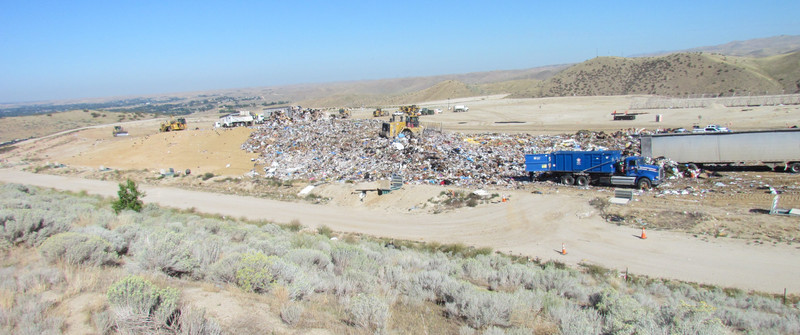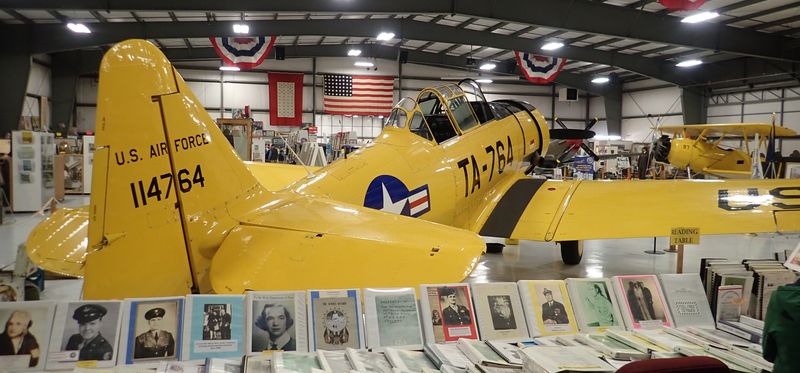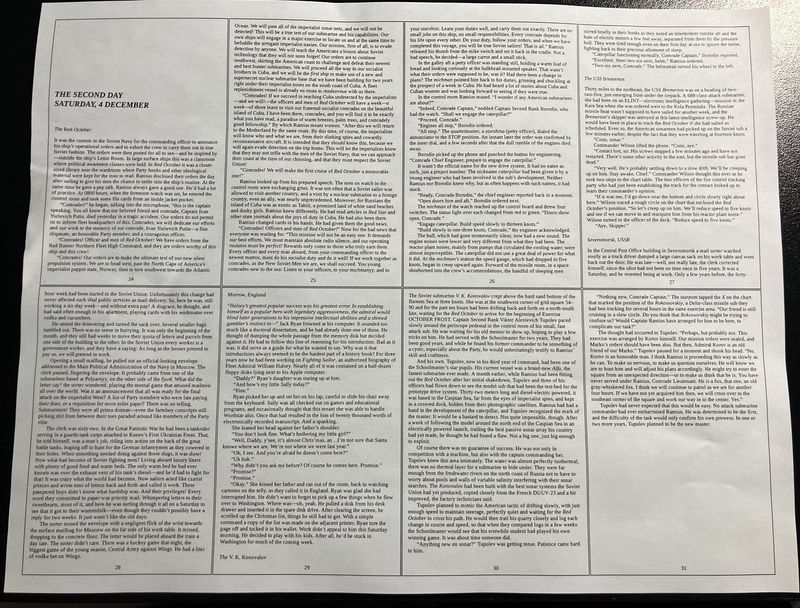This week is something rather different, even for me! I’m posting about a tour of the Ada County Landfill, a bit north of the Boise area. It’s not even the landfill I drop stuff off at, but I had a chance to tour it, so my family and I went for a very nice behind-the-scenes tour of the place and got to see a lot more than you normally do! Plus the usual stuff you see - but from some different angles!
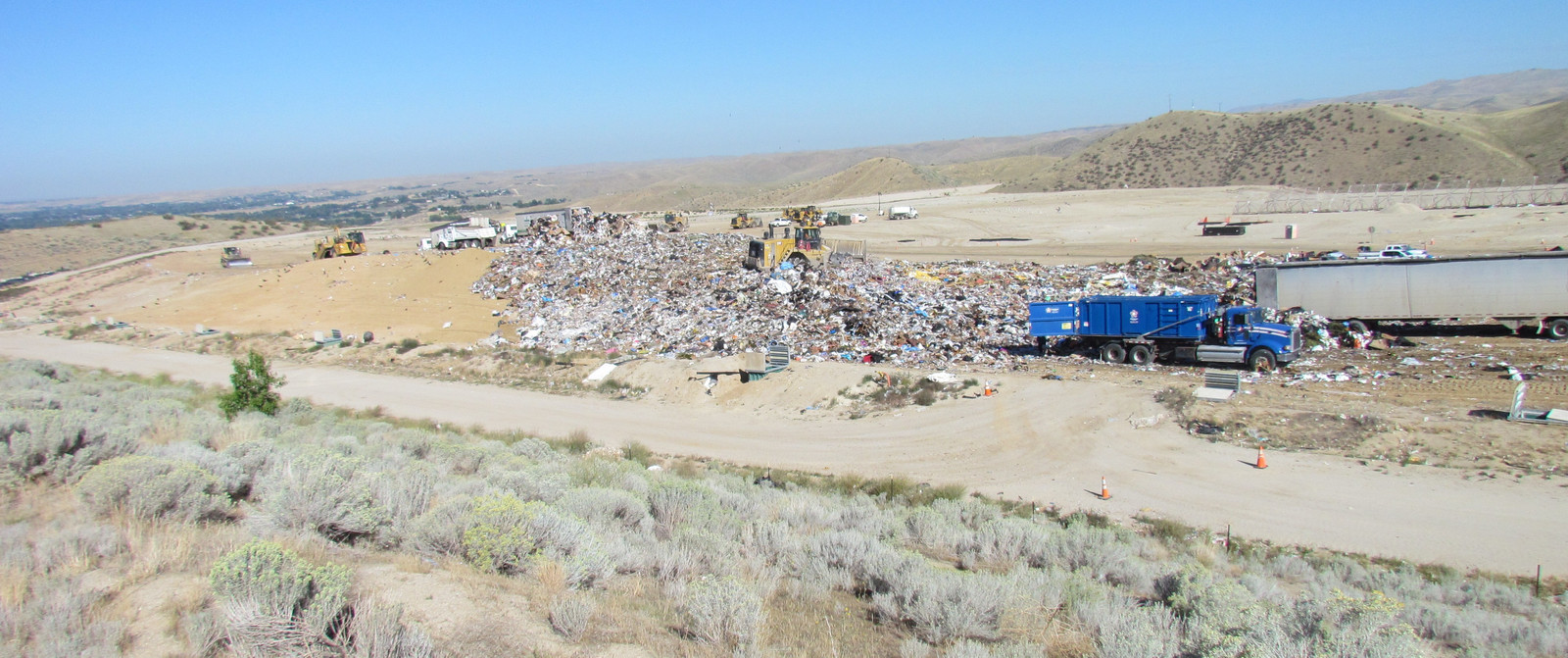
Ada County Landfill Tours
While there are no scheduled tours of the landfill, if you’re interested in a tour for you or a group (of pretty much any size), reach out to Rebecca Weeks. She’s the landfill’s Education and Outreach Manager, and she’s the one who arranges and gives the tours. If you’ve got a homeschool group or even just a bunch of interested students, reach out and see what can be arranged!
I’ve been hauling my own trash for quite a few years now (the trash trailer is still working just fine!), and my kids tend to come with me when I haul trash every 16-18 months, so the basics of landfills aren’t new to any of us, but seeing the other side of stuff and being able to ask questions beyond “Where should I dump it?” and “How much do I owe you?” was quite nice. If you’ve never been to a landfill - or if your kids haven’t seen it, it’s absolutely mind boggling just how much waste there is to deal with from even a fairly small city. The Ada County landfill is very aggressive in trying to divert waste streams off - recycling, reuse, etc, but even with all that, they’re running into the very real problem of “They’ll be out of space far sooner than expected because of the growth in the area.” The current landfill location was intended to last 100 years, but at current rates, it’ll be full in under 60 years. We absolutely live in a throwaway society, and a landfill is a great place to see the other end of your local waste bin.
Also, unlike the Canyon County landfill I use, Ada County has some of the more interesting technology (gas extraction and water leachate processing systems), plus onsite power generation from the landfill gasses.
Plastic Reuse: Hefty Energy Bags
We don’t just live in a throwaway society - we live in a plastic throwaway society, and because of the wide variety of ways and chemistry one can use to make things all known as “plastic,” the recycling process for them has tended a lot more “Yeah, yeah, uh… we shipped it to China because they said they’d deal with it…” than anything most people would call “recycling.” China stopped taking containers full of trash in 2017, and so there’s been a bit more innovation recently in “ways to make something useful with the chemical cocktails called plastic.”
Ada County has been partnering with Hefty in the “ReNew program” (formerly the EnergyBag program) for some while now, and so they have a steady suppy of “weird plastics” - stuff that isn’t your normal #1/#2 jugs and bottles. The original plan to turn it into diesel fuel didn’t really work out, so a bunch has been going to a cement kiln in Utah to be burned in place of coal, but there’s also some other work that’s been done more locally with it, and a few of these options are on display at the education center (still a work in progress - it’s the old office building at the entrance).
The biggest blocks on display are some ByFusion ByBlocks - and if you’re curious about the details, you can look over the datasheet too. These are built in a steam forming process - I think it’s steam and a lot of pressure, though I don’t have details yet. They’re intended to be used as a tensioned building material - a threaded bit of rebar goes through them to help compress them together into the final shape. Each one is about 22 lbs of post-consumer plastic waste, though there are some concerns related to microplastics with this as a building material. It probably should be covered in any sort of actual use, and it’s not the slightest bit fire resistant without extra coatings or materials around it.
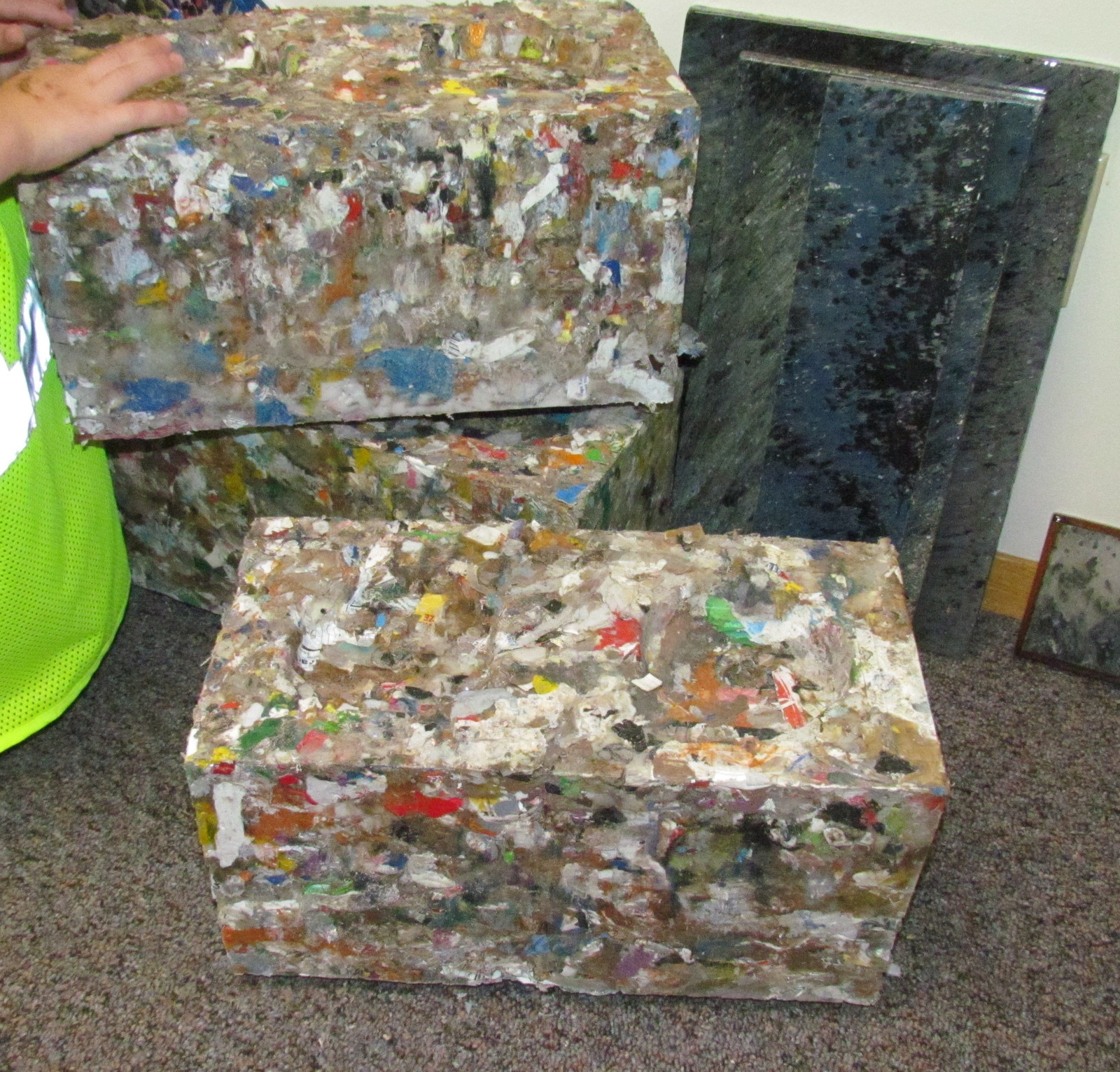
Each block is unique. They’re… interesting. Unfortunately, they also are prone to soaking up water - so while they’re plastic and it shouldn’t harm them, they aren’t a “one and done” sort of product. I’d be interested in leaving a few out in the weather on our hill to see how they hold up to the extreme UV that seems to rot just about everything plastic around here.
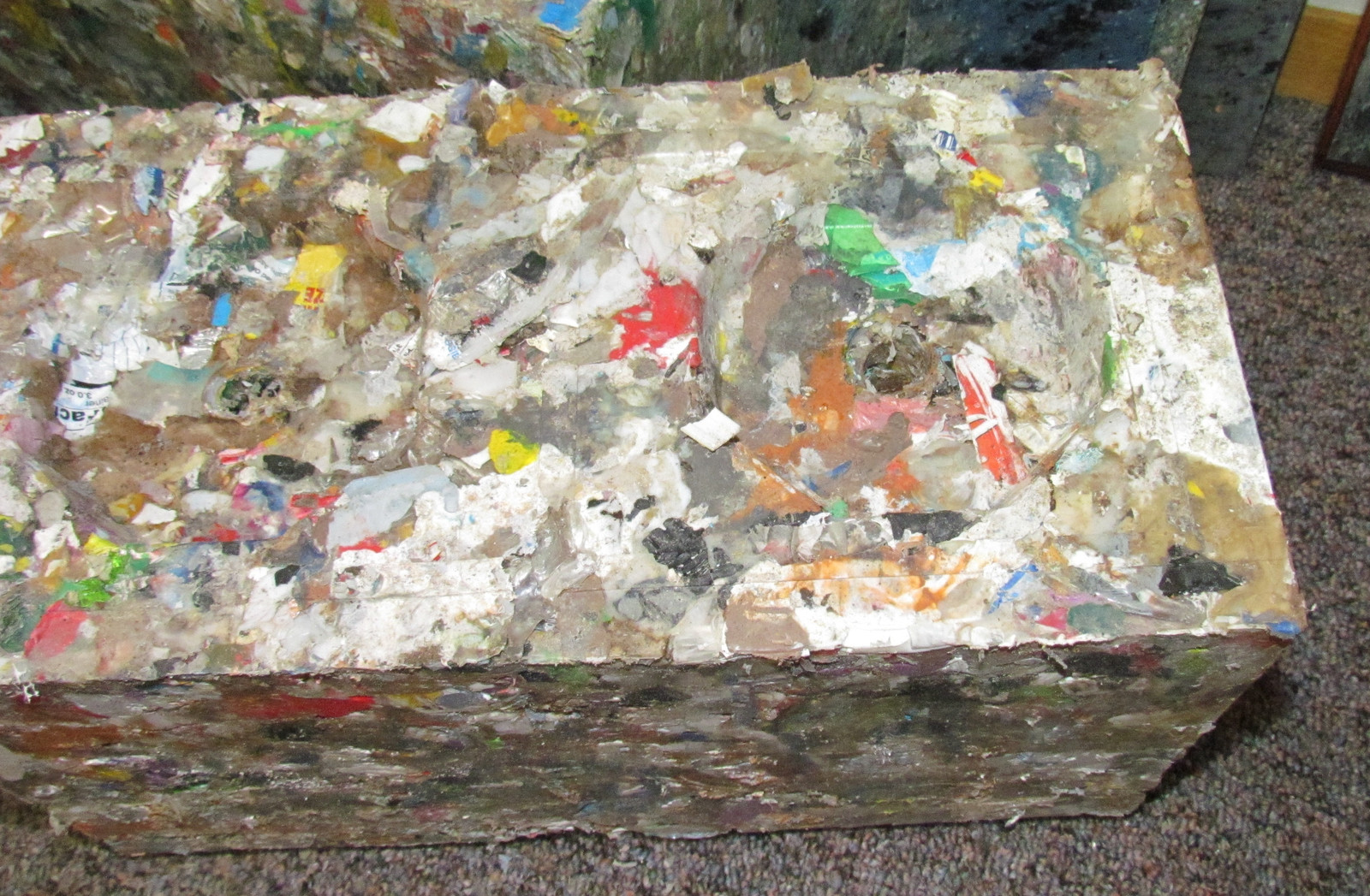
A professor over at Boise State is also doing some work with the plastics, and has generated some materials that seem a bit more refined - though they also require more processing and grinding the plastic into small pieces before it’s formed into something that feels a bit like a hunk of countertop.
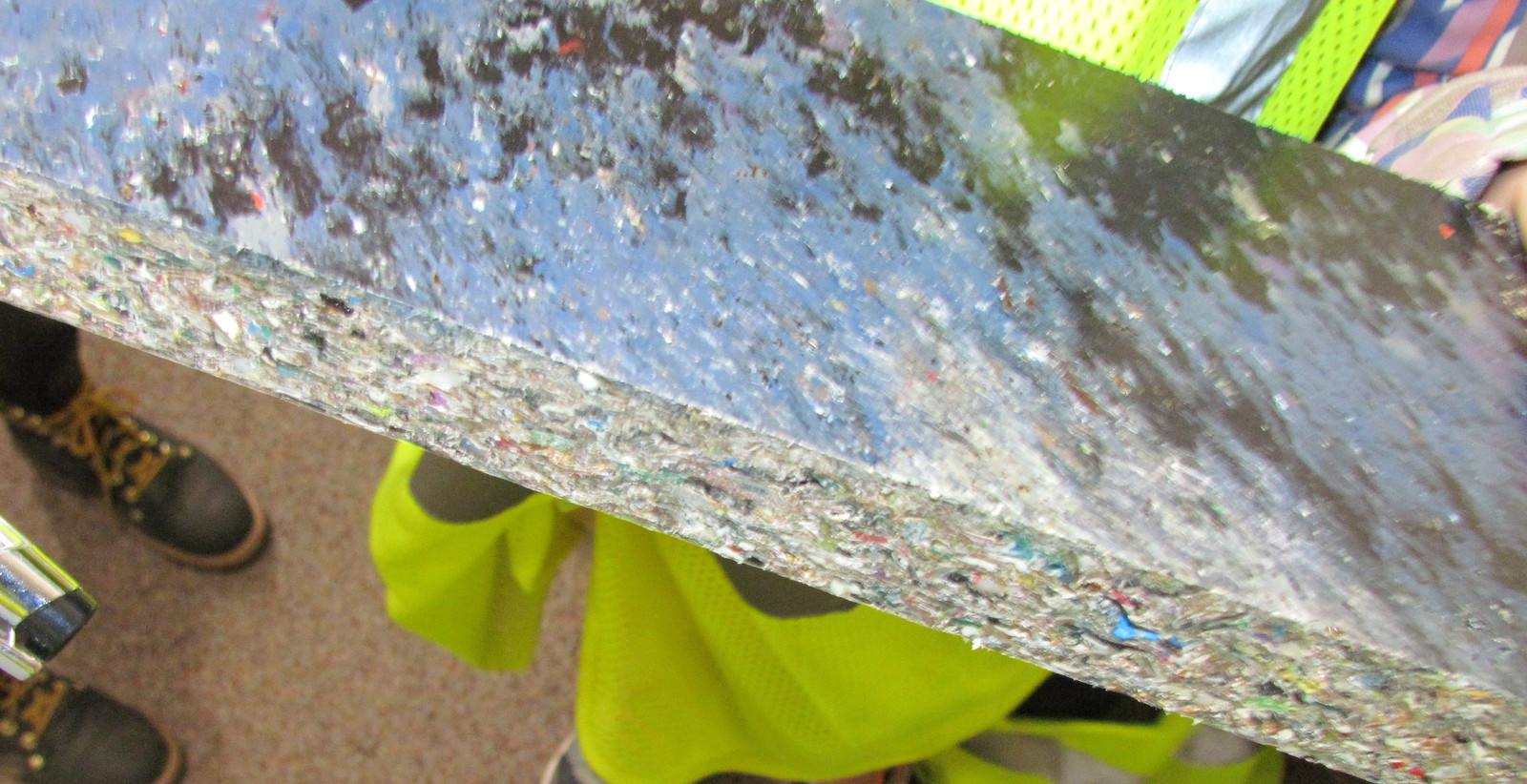
The surface finish isn’t perfectly smooth, but it’s a much more refined product than the ByBlocks for interior use, and seems quite a bit better bonded together as well. I’m going to try and find more details on this down the road.
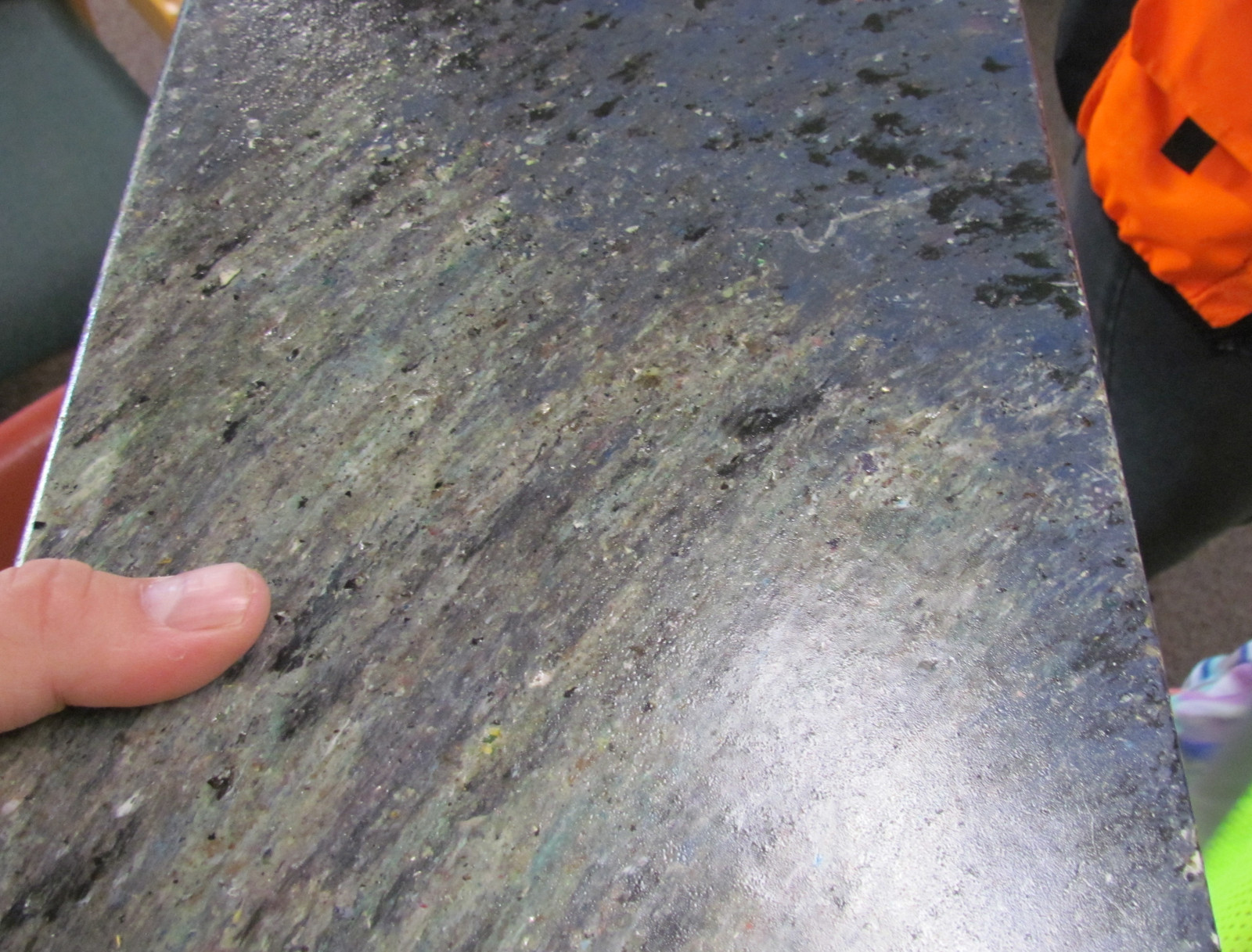
Wrap it in some wood, give it an epoxy coat, and you’ve got what should be a rather indestructible coaster as well!
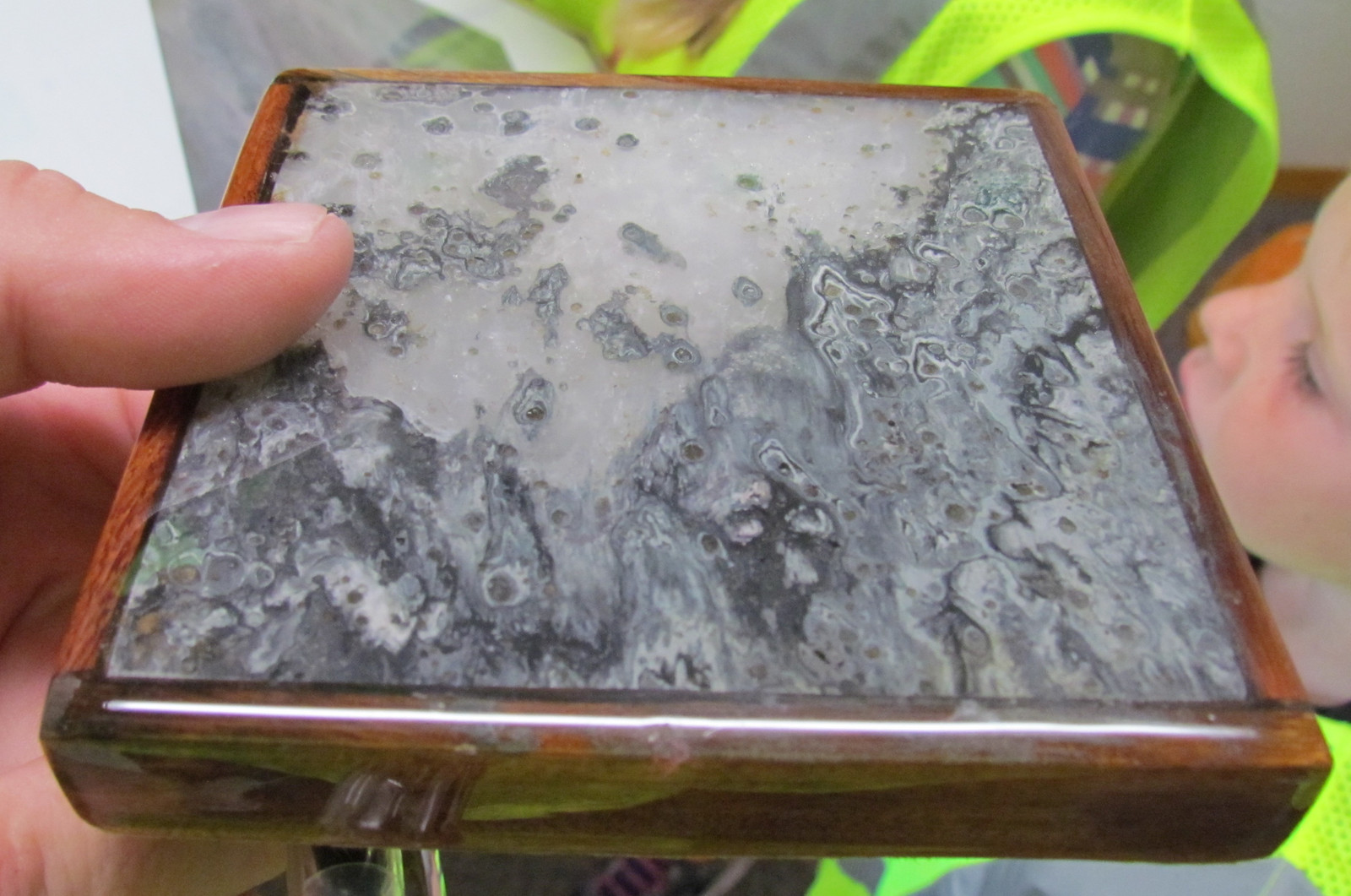
The ReNew Bags are intended to take a lot of various plastics that can’t be processed in other ways, which is why I use them out here - I’m not in the service area, but I just drop them off somewhere that collects them every few months when I’m out that way (yes, I live by Boise, no, I don’t go there very often). It’s amazing (actually, really depressing when you think about it) just how much of a household waste stream is “weird plastics.”
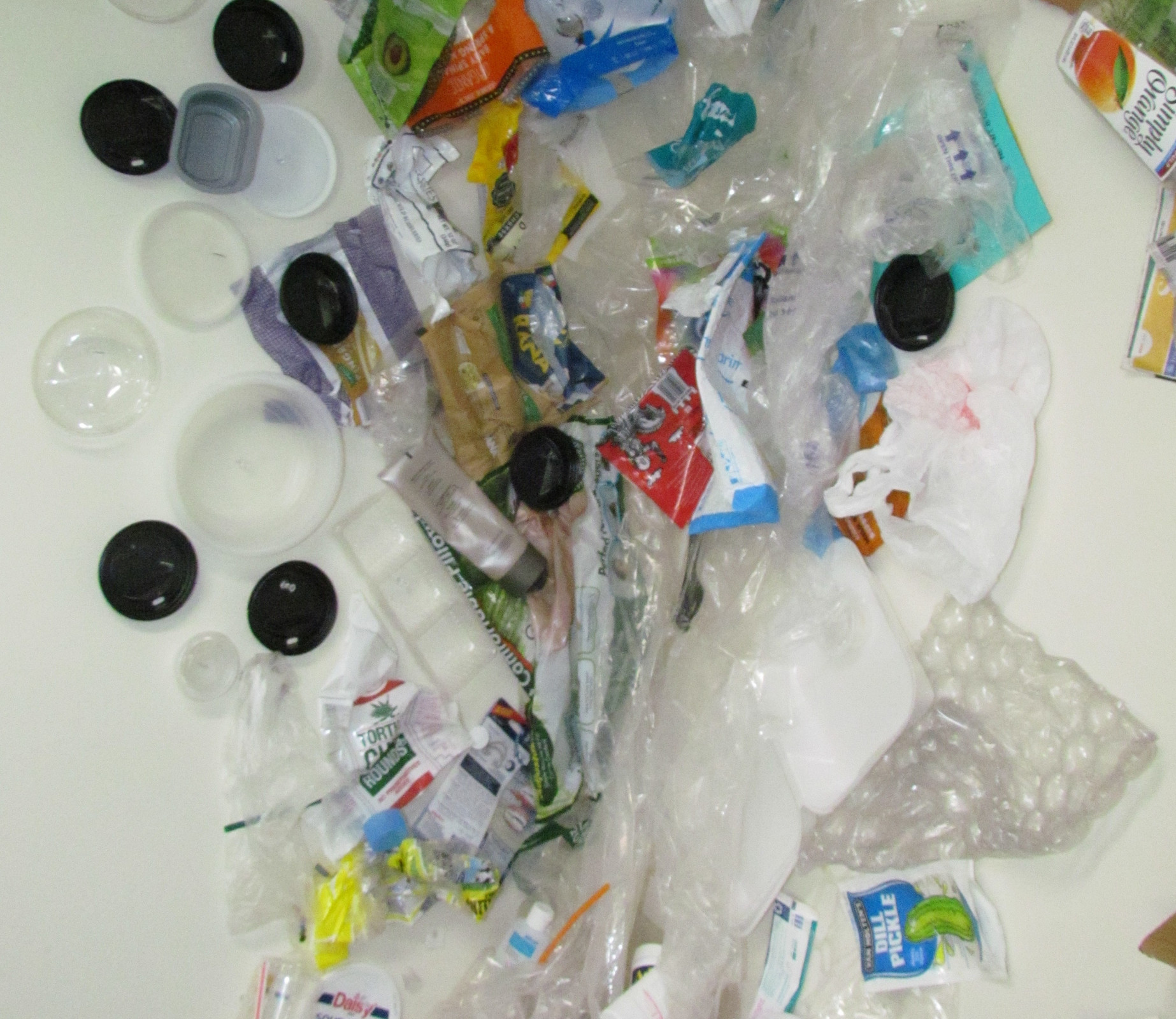
Unfortunately, some of the plastics that we use aren’t suited to the ReNew program - most commonly the various clamshell boxes. I’m trying to learn more about this as well, because it seems some methods would deal with them just fine (burning the plastics or grinding them). I’m certainly looking for more detailed information as I can find it down the road!
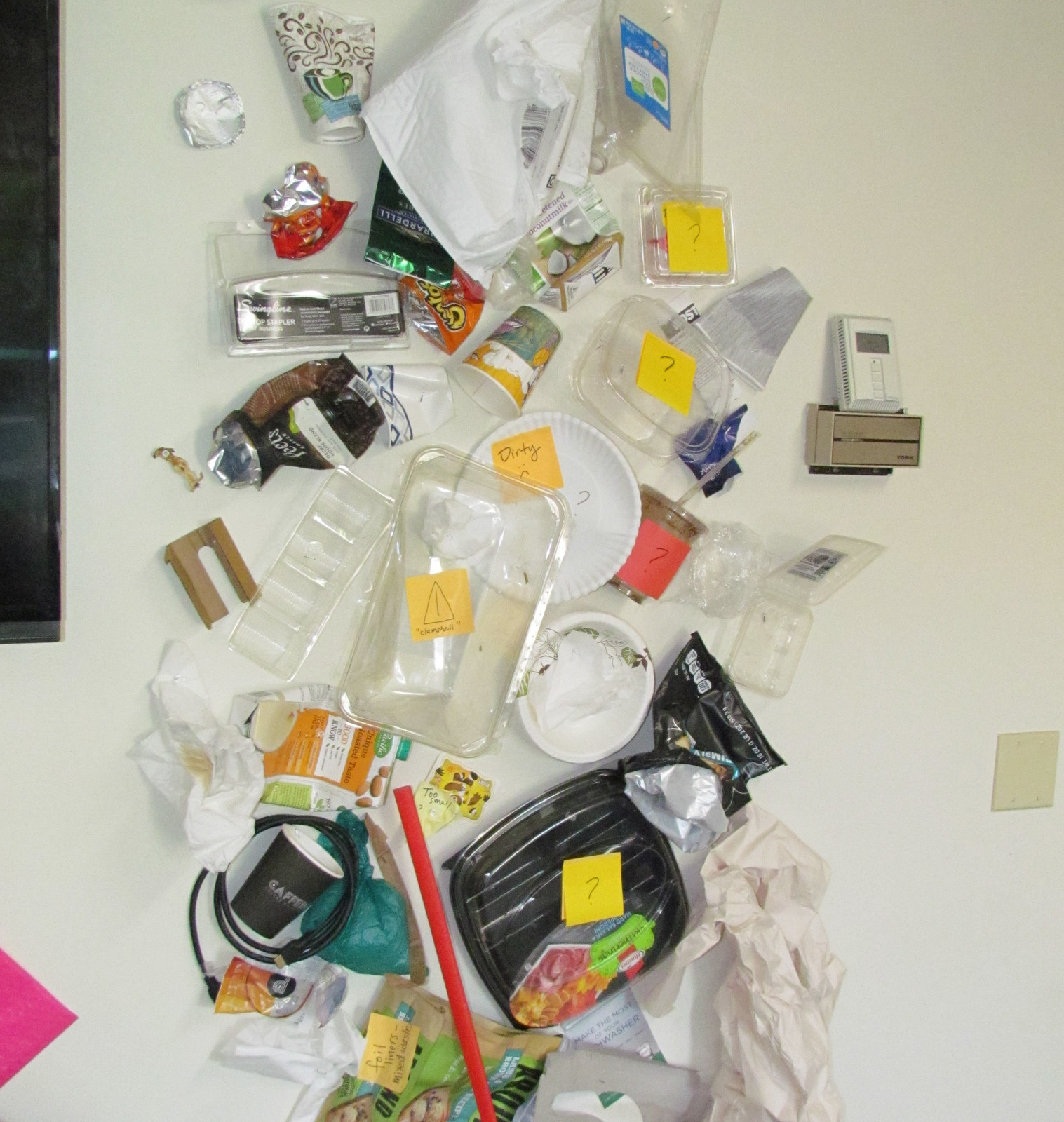
The landfill also takes normal home electronics waste. Some of it goes to a processing center in Colorado, though apparently the flat screen TVs are provided to a local “rage room” - which, after looking it up (I’d not heard of the concept before), seems to be a place in which you pay to smash up household items for entertainment, or stress relief, or… something. Just in case you didn’t think we had too much stuff as a society.
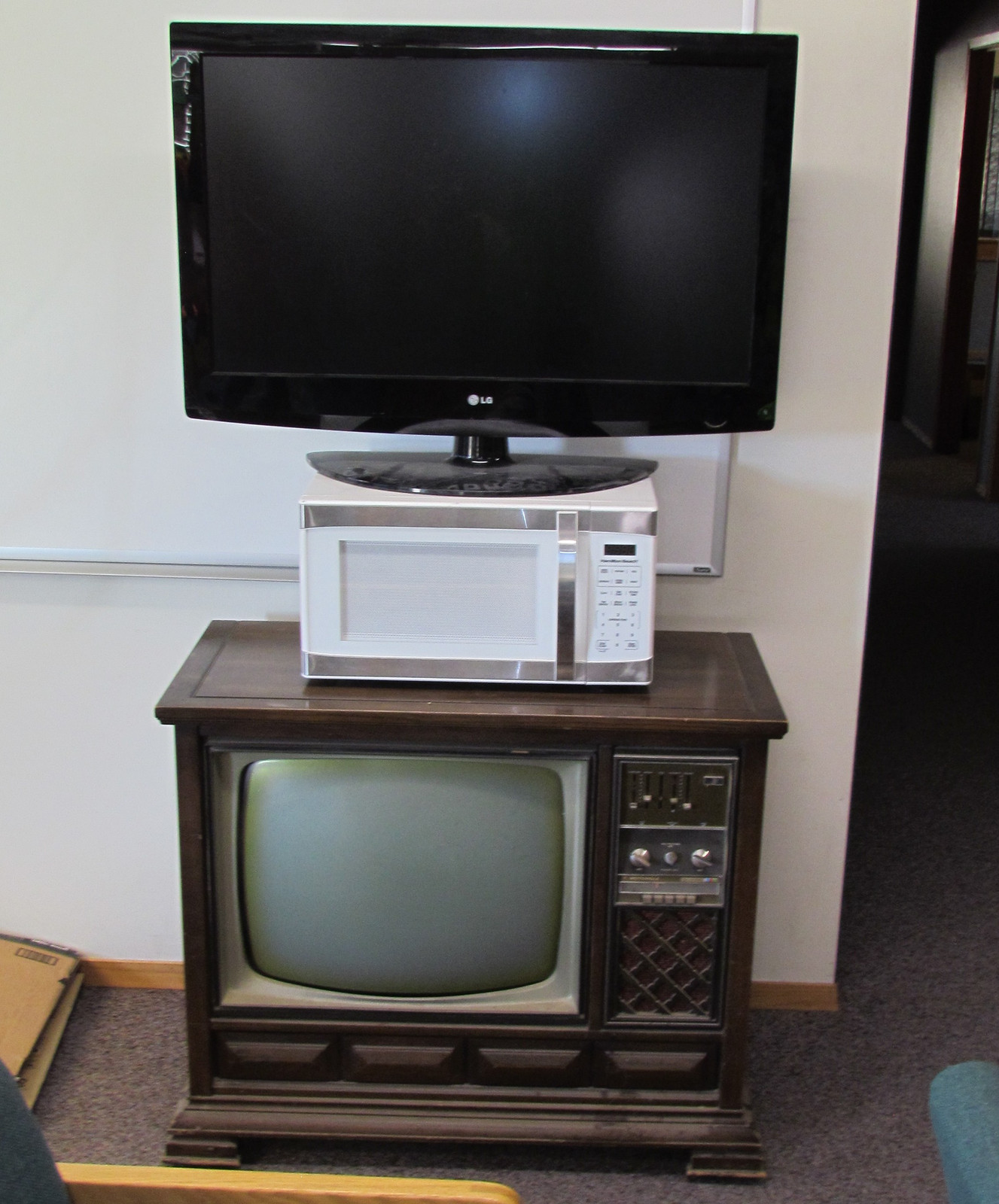
The Hidden Hollow Landfill
Our first stop on the tour was the old Hidden Hollow Cell. This is a section that was opened in 1972, and was sealed up for good in 2018. This contains a final mass of 7,770,000 tons of waste, a volume of around 16 million cubic yards, and is deep into anerobic decomposition (generating a lot of methane). Once finished, the compacted trash was covered with about 6 feet of dirt, and then seeded with various native plant species.
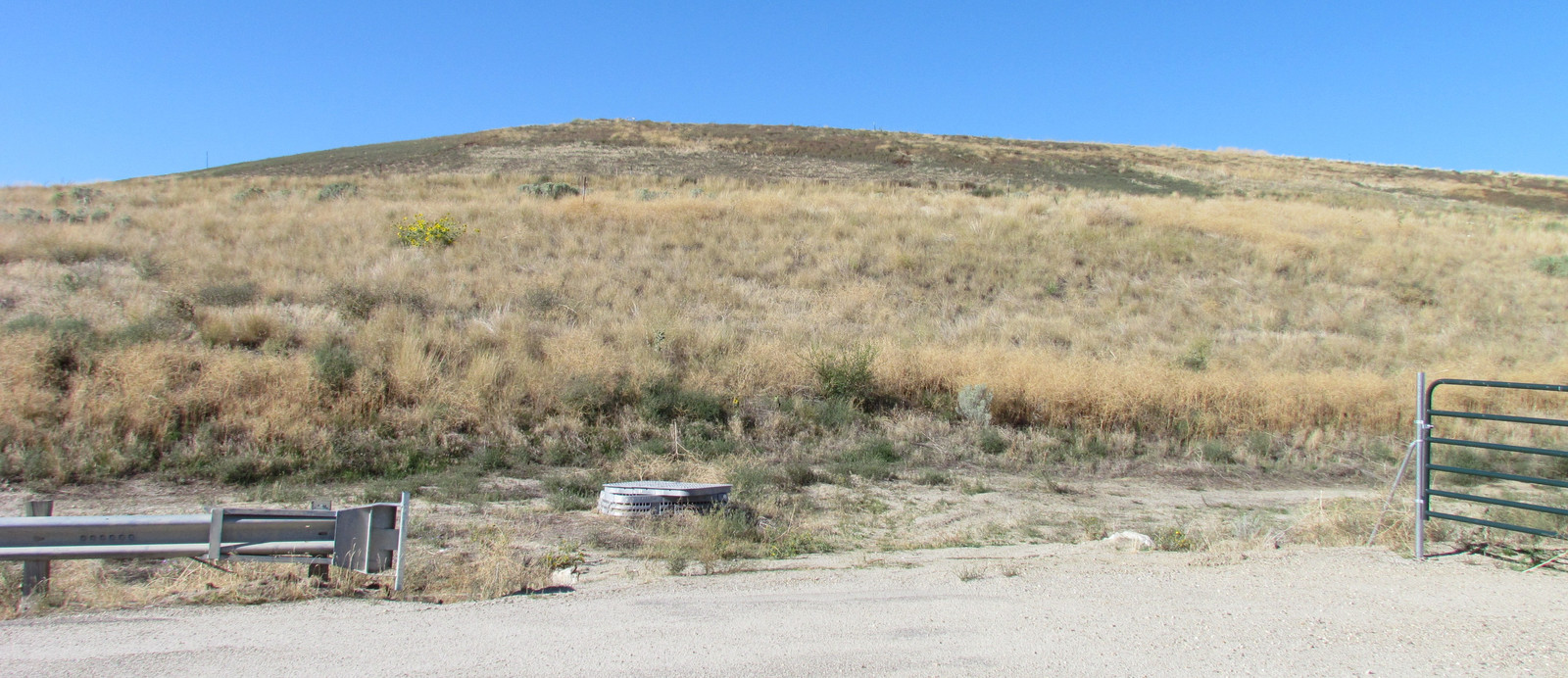
I like my zoom lens. See that thing just to the left of the peak in the previous image? It’s a well head that looks exactly like this. Throughout the old landfill are 371 extraction wells, up to 200 feet deep. These provide a path for the landfill gasses (methane, carbon dioxide, nitrogen, hydrogen sulfide, and scattered other trace gasses) to escape into a collection system for later processing and use.
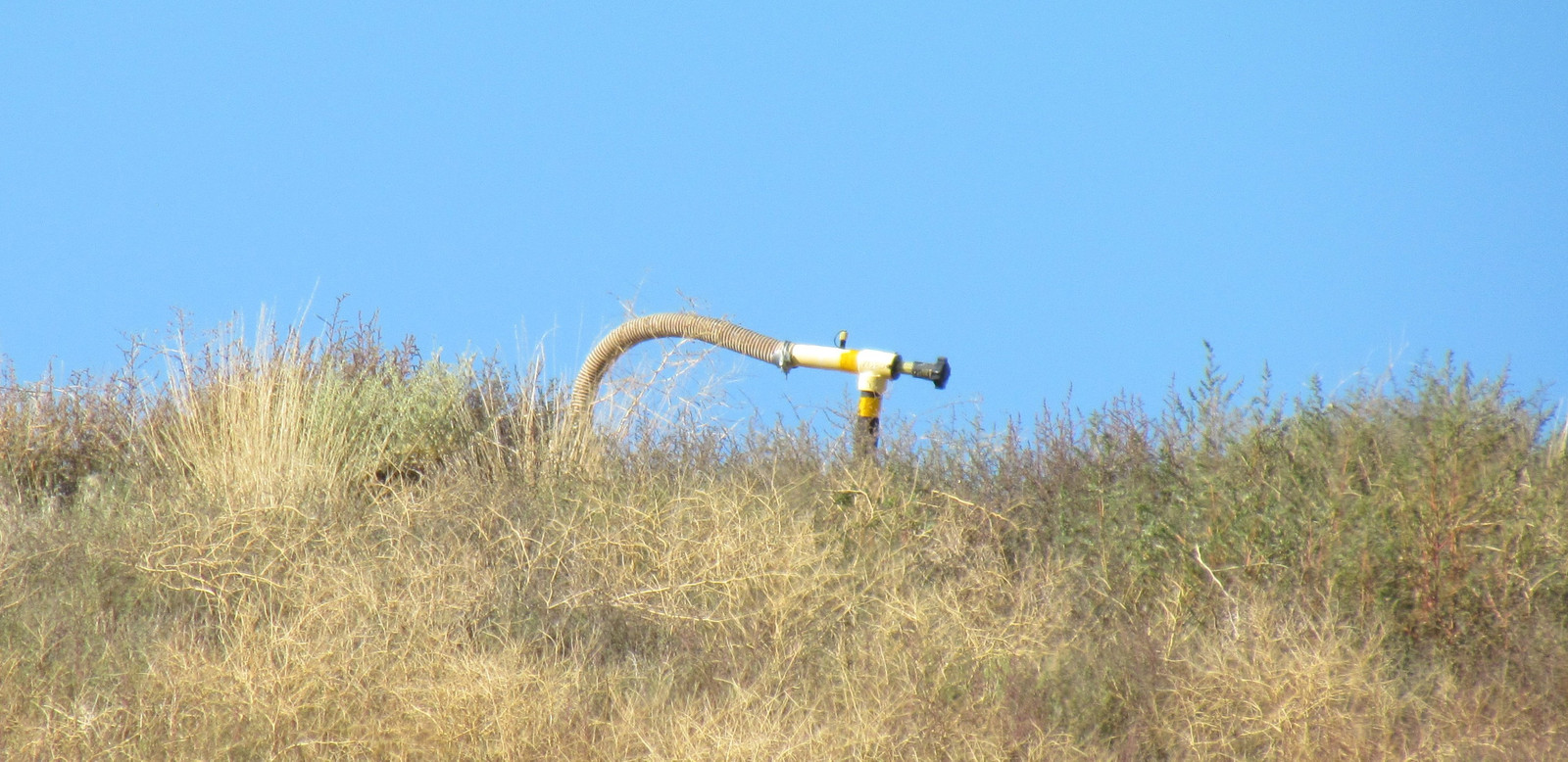
Around the base of the mound, a concrete ditch serves to route water - both to handle water coming from the mound, as well as to prevent water from elsewhere from leaking in and adding to the water handling requirements. Water that’s gone through the landfill is called leachate, and is handled on-site as well.
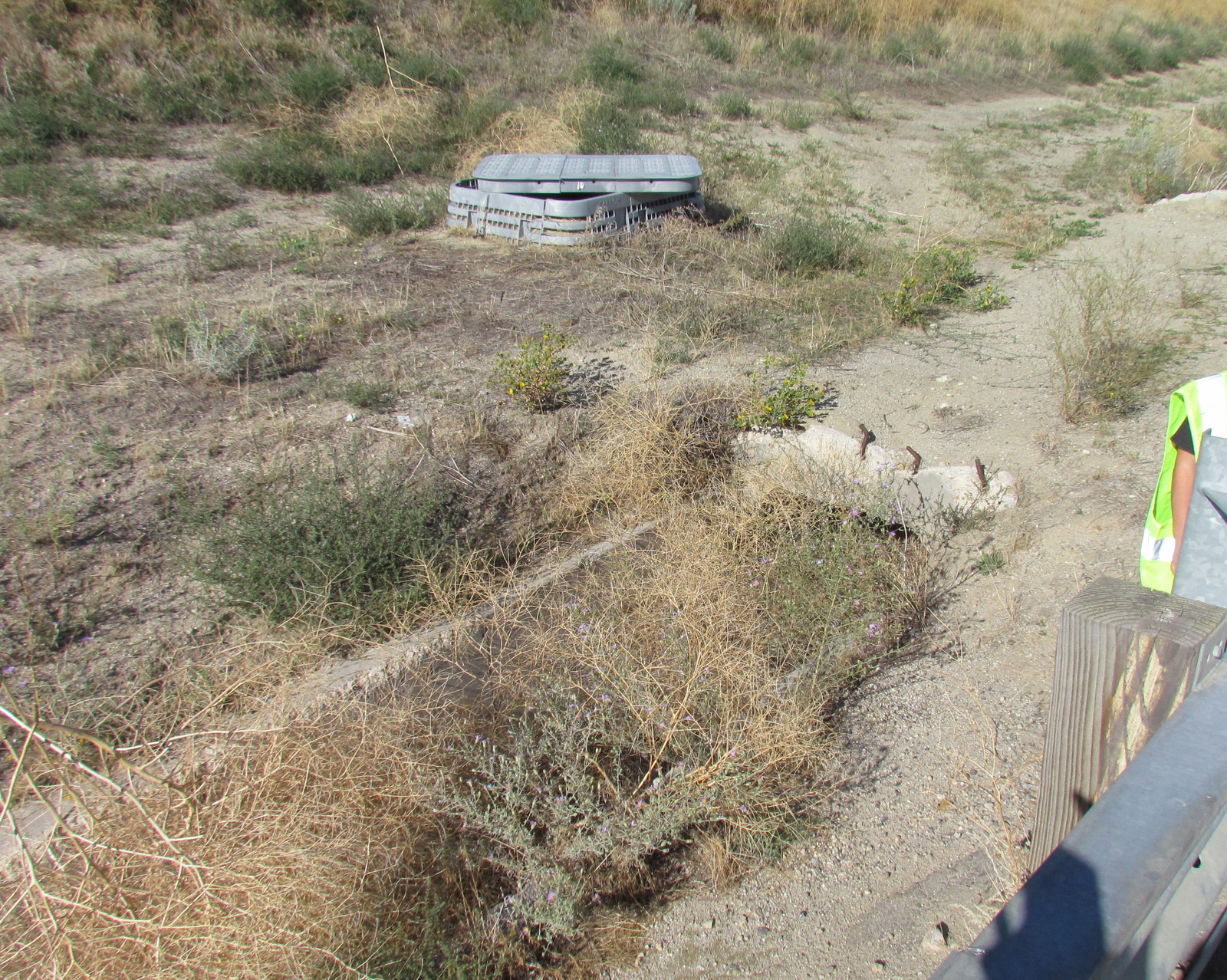
Finally, there are some in-ground wells - which are an excuse for a bit more detail on the well heads. They’ve got a main shutoff valve (in the back), a fine flow control valve at the top, and some piping. The system runs at a negative pressure - to help prevent leaks, gasses are sucked out through the system. There’s also regular monitoring of the wells to ensure they’re behaving as expected. The entire gas extraction system seems to be fairly high in terms of manual monitoring and control, but it keeps things routed for proper handling.
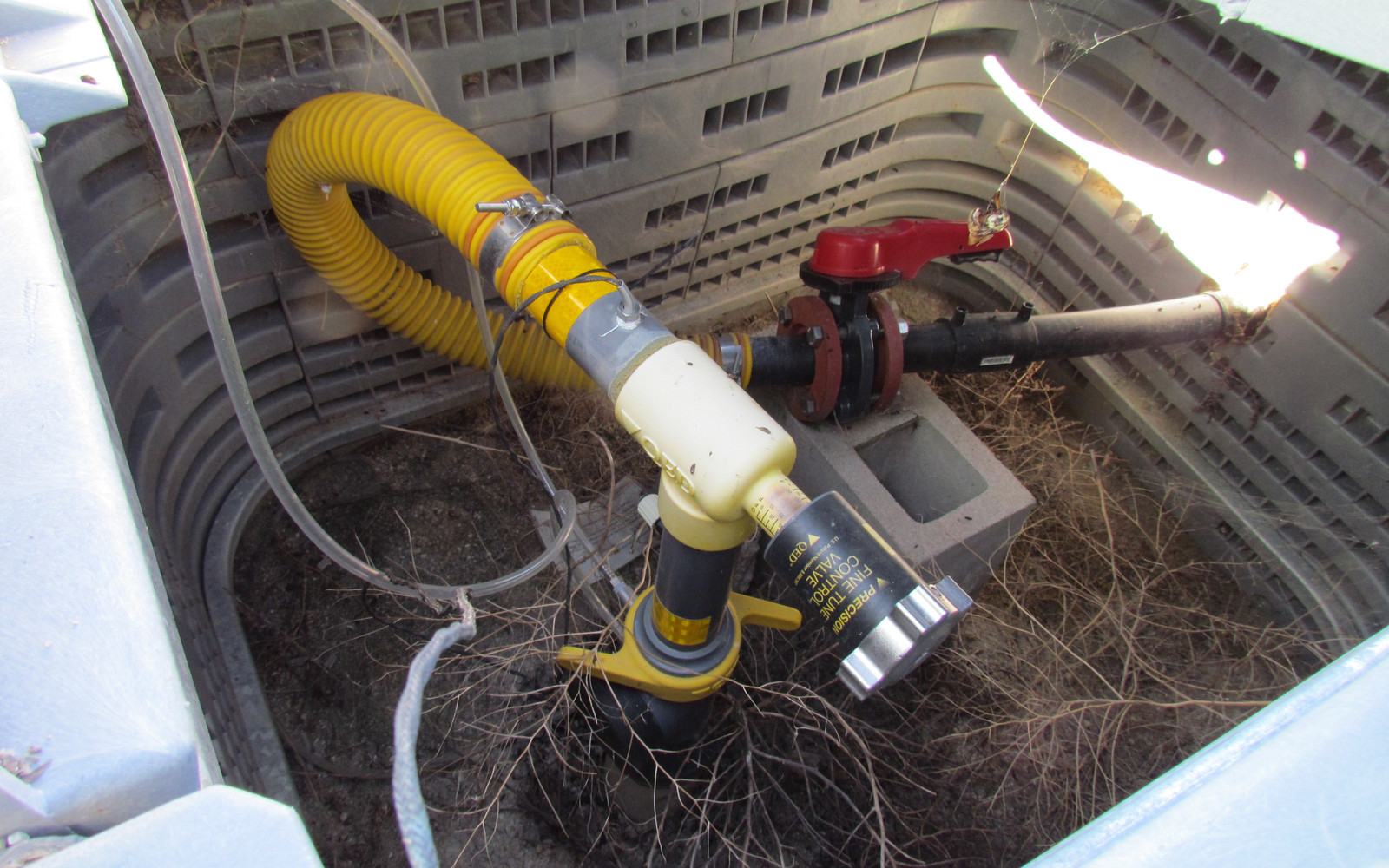
There are a lot of these well heads scattered around the finished landfill.
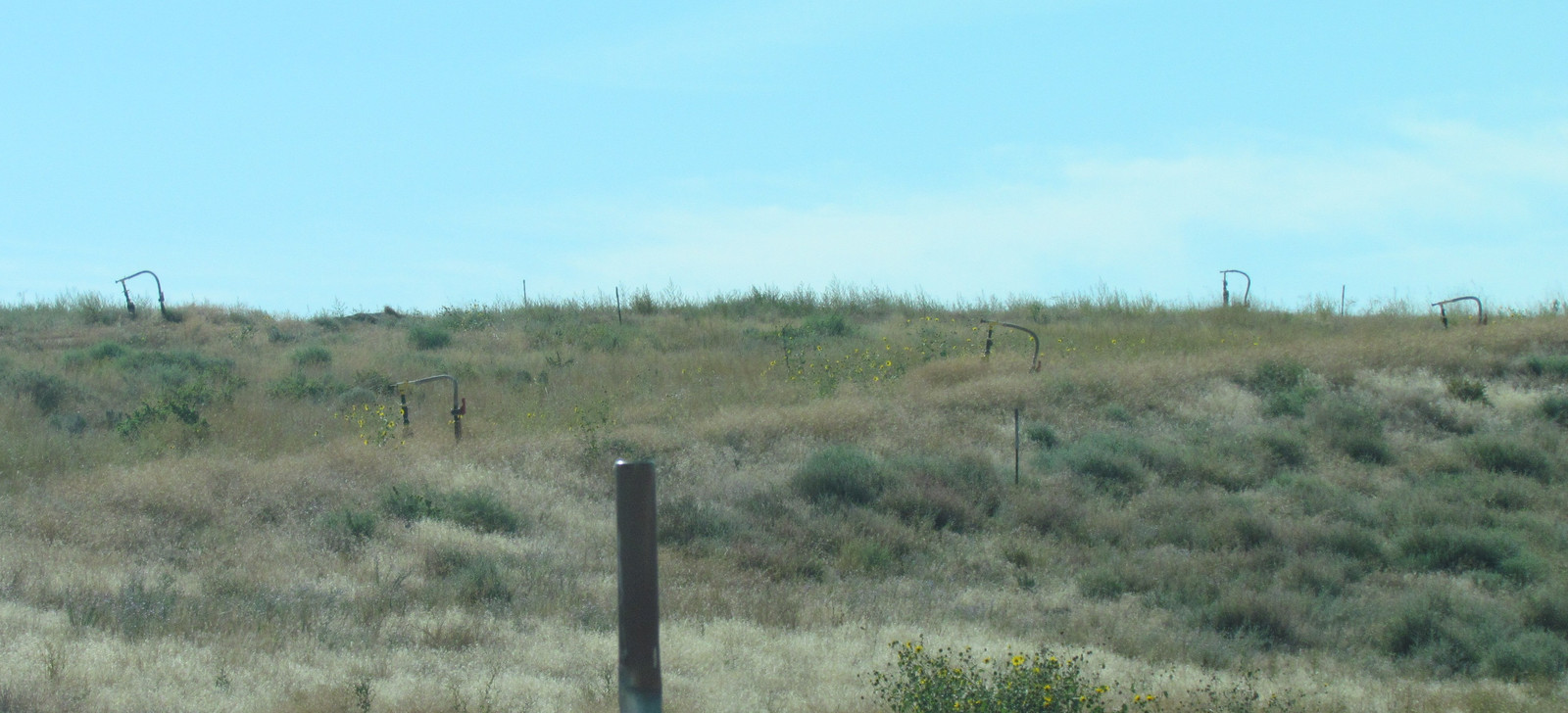
The Scalehouse
Our next stop was the scalehouse - and while you normally see this when you drop stuff off, you don’t normally get to see the inside of it! At every landfill (or transfer station) I’ve been to, cars and trucks are weighed in and weighed out. The difference is what you left behind - so you get charged for it. Ada County currently charges about $30/ton (with a $15 minimum charge - always try to make minimums when you’re hauling trash or you’re wasting money).
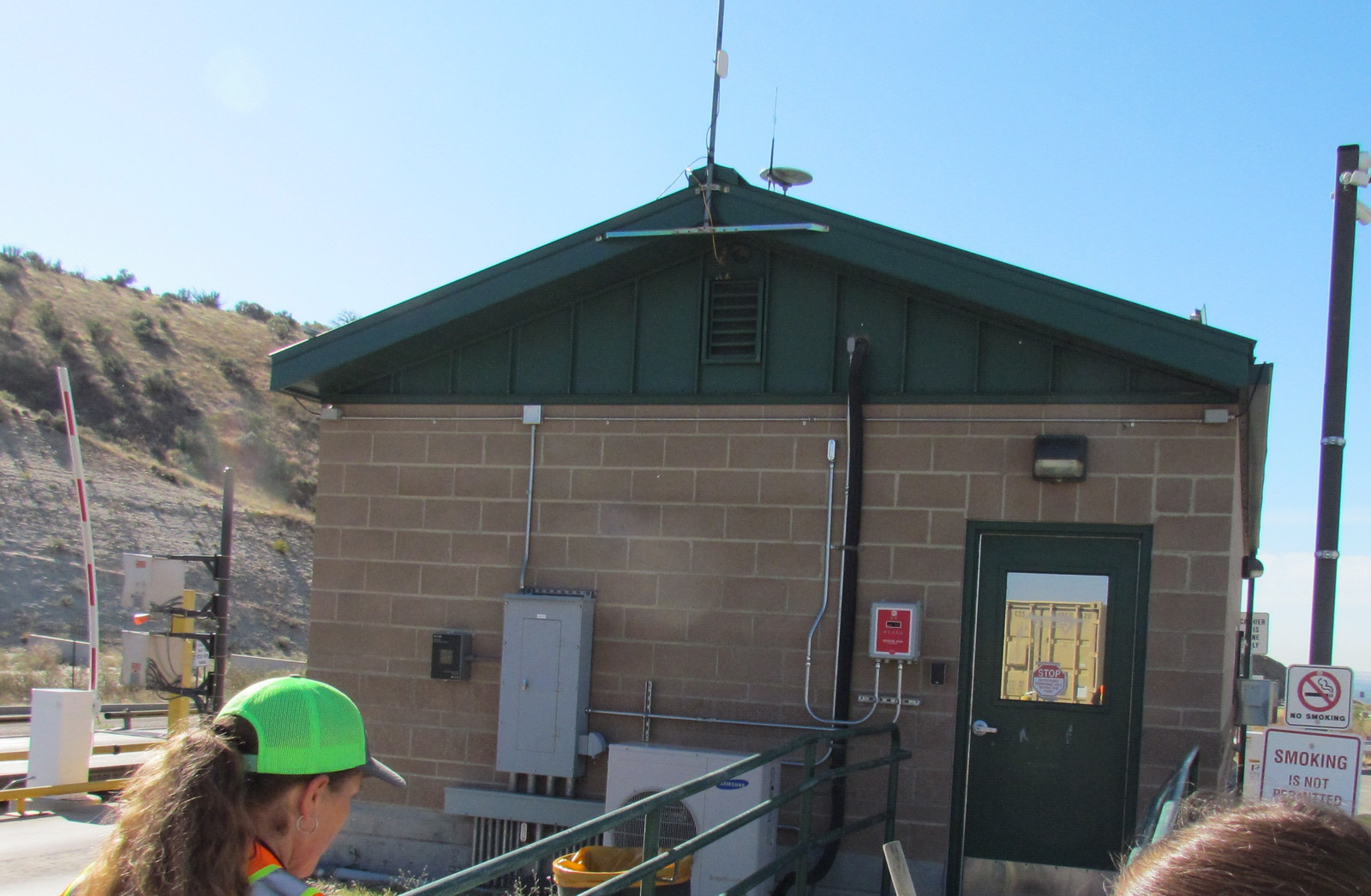
Inside, it’s mostly windows and monitors, with a few people manning the various stations. Because the landfill is accessed via a rather winding road, some remote cameras let the staff see what’s coming up the hill. They weigh people in, make any special notes about the load (tires, hazmat, “just here for birdwatching,” etc), and send you on in.
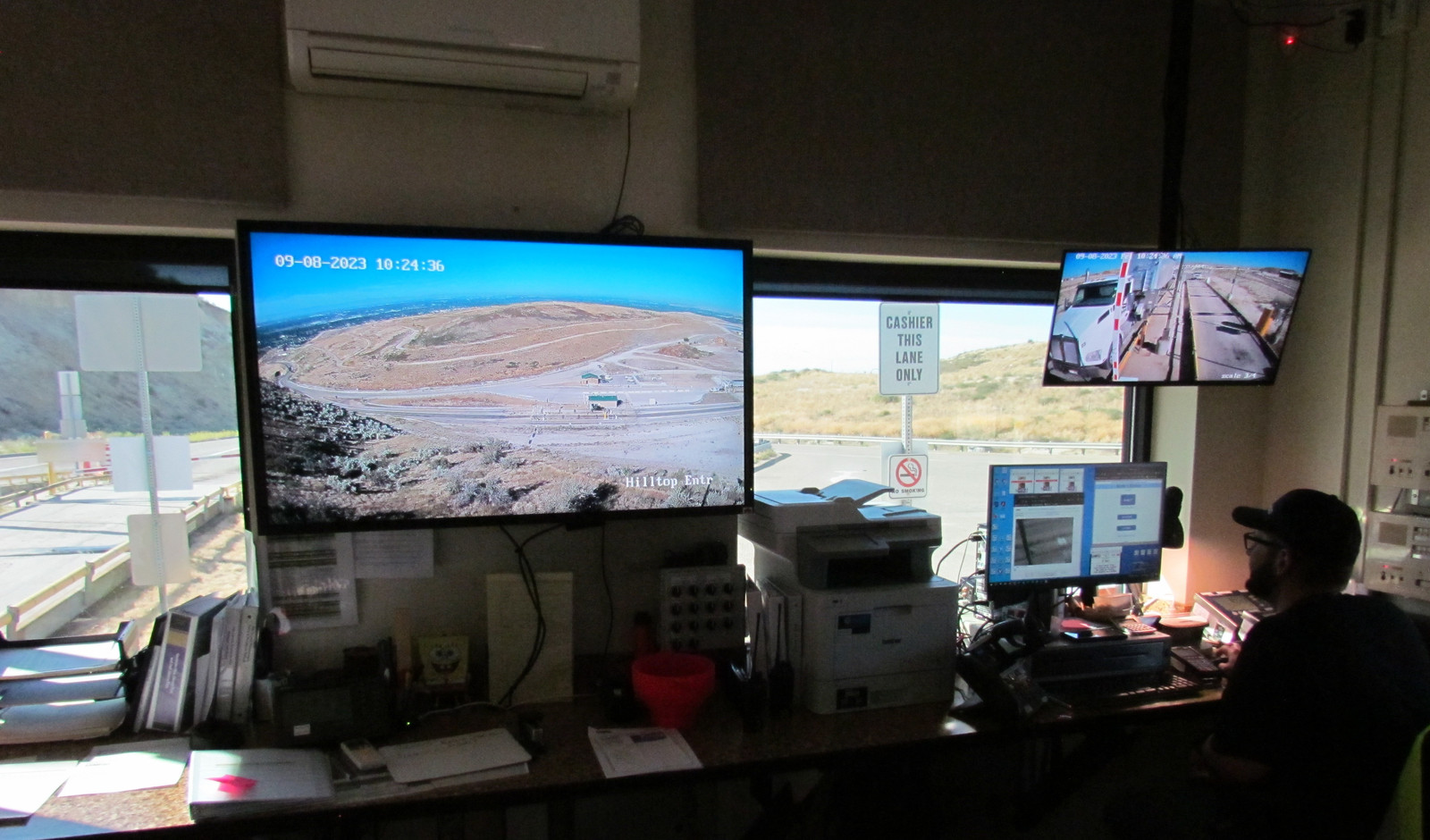
As we walked out, one of these monsters was rolling off as well. These are trucks from the transfer stations - remote landfill outposts where you can drop trash off without having to go all the way to the landfill. The trailers are apparently quite heavy - 100k lbs isn’t uncommon, which explains the extra axles. I’ve seen them loaded from the top, and they unload out the back with some automated conveyer systems.
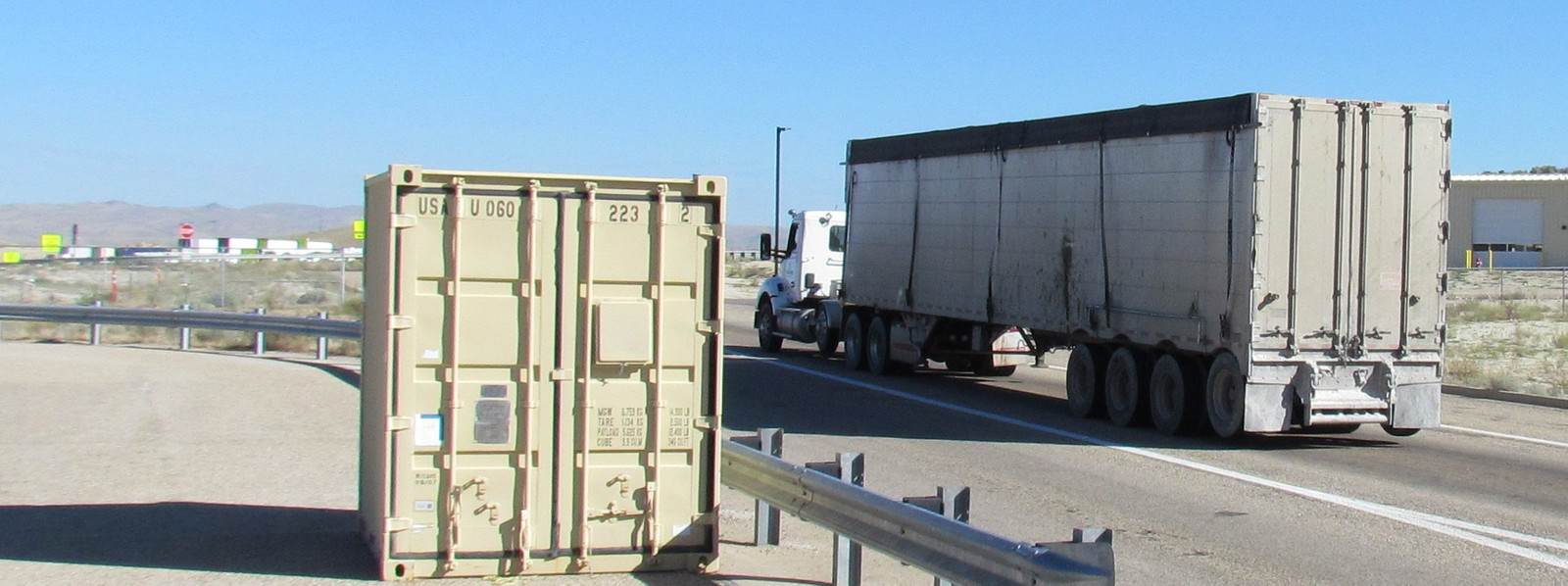
The… Drone?
We saw one of these buzzing around too. It looks like some sort of small fixed wing drone, and flew like it too. Any idea what it is?

Diversion
One of the major goals of Ada County Landfill is to divert as much waste out of the actual landfill as possible. They work to implement the “Reduce, reuse, recycle” hierarchy, and I’m really glad to see it. There are a lot of “diversion” piles for various things that are processed down - though I’m told if you have some compelling use for the stuff as-is, talk to them and they can probably work with you.
Wood - pallets, lumber, trees, etc, is all collected to be processed down into wood chips for other use. Or, I have to imagine, the occasional after-hours landfill employee bonfire…
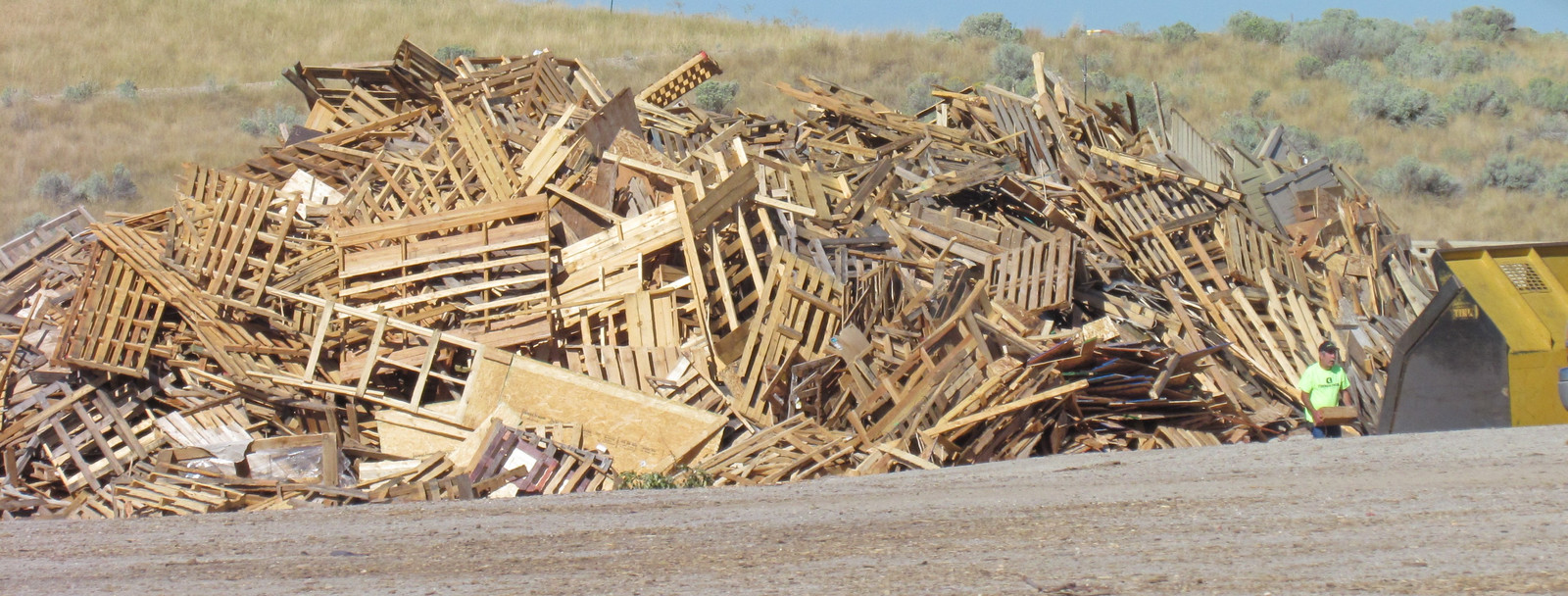
“Refrigeration equipment” (with some sort of refrigerant that should be recovered) is stacked in another area - mostly fridges, freezers, and window air conditioners. These are processed somewhere to safely extract the refrigerant before they’re recycled as metal scrap.
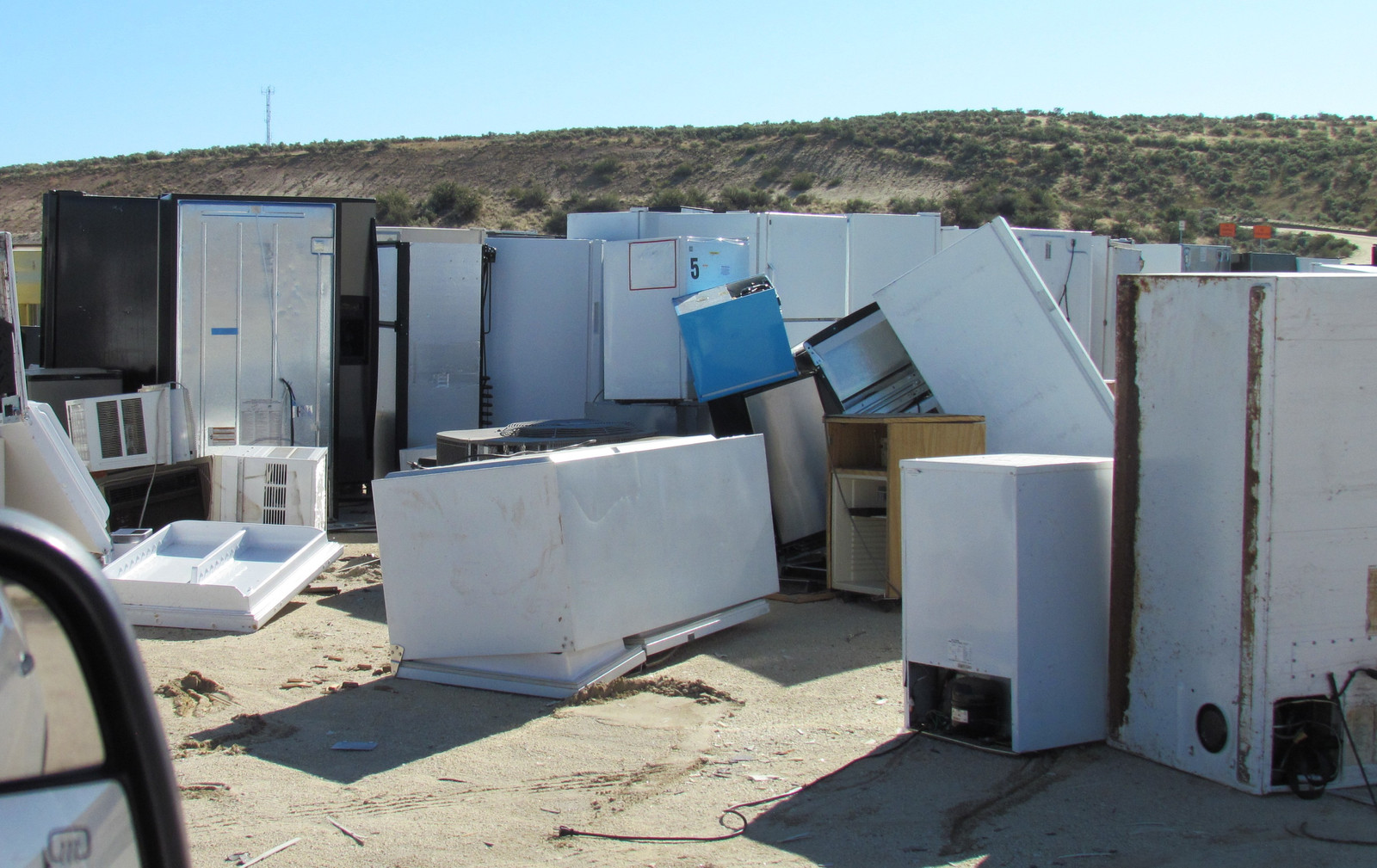
Tires are a pain in the rear for landfills, because they don’t compress well, they hold water, and if you’ve seen The Simpsons, you know that piles of them can be almost impossible to put out when they catch fire. Tires can be reprocessed into various other rubber “things” - I’m not sure how the metal wire is extracted, but it’s a process. You have to pay extra for each tire you bring in - this is why most tire shops have a “tire disposal fee” if you don’t take your tires with you for some other purposes (say, half burying in the ground for kids to play on).
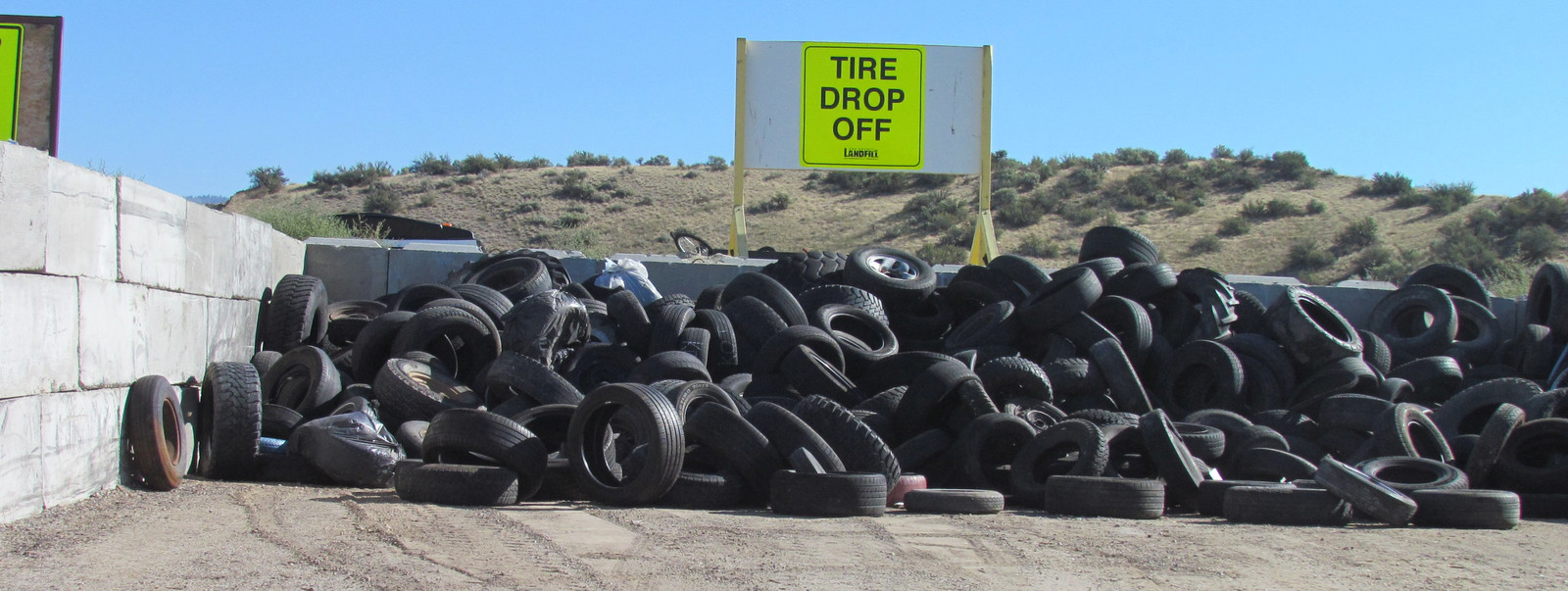
I don’t know why you’d go all the way out to the landfill to recycle cardboard, but it’s collected as well.
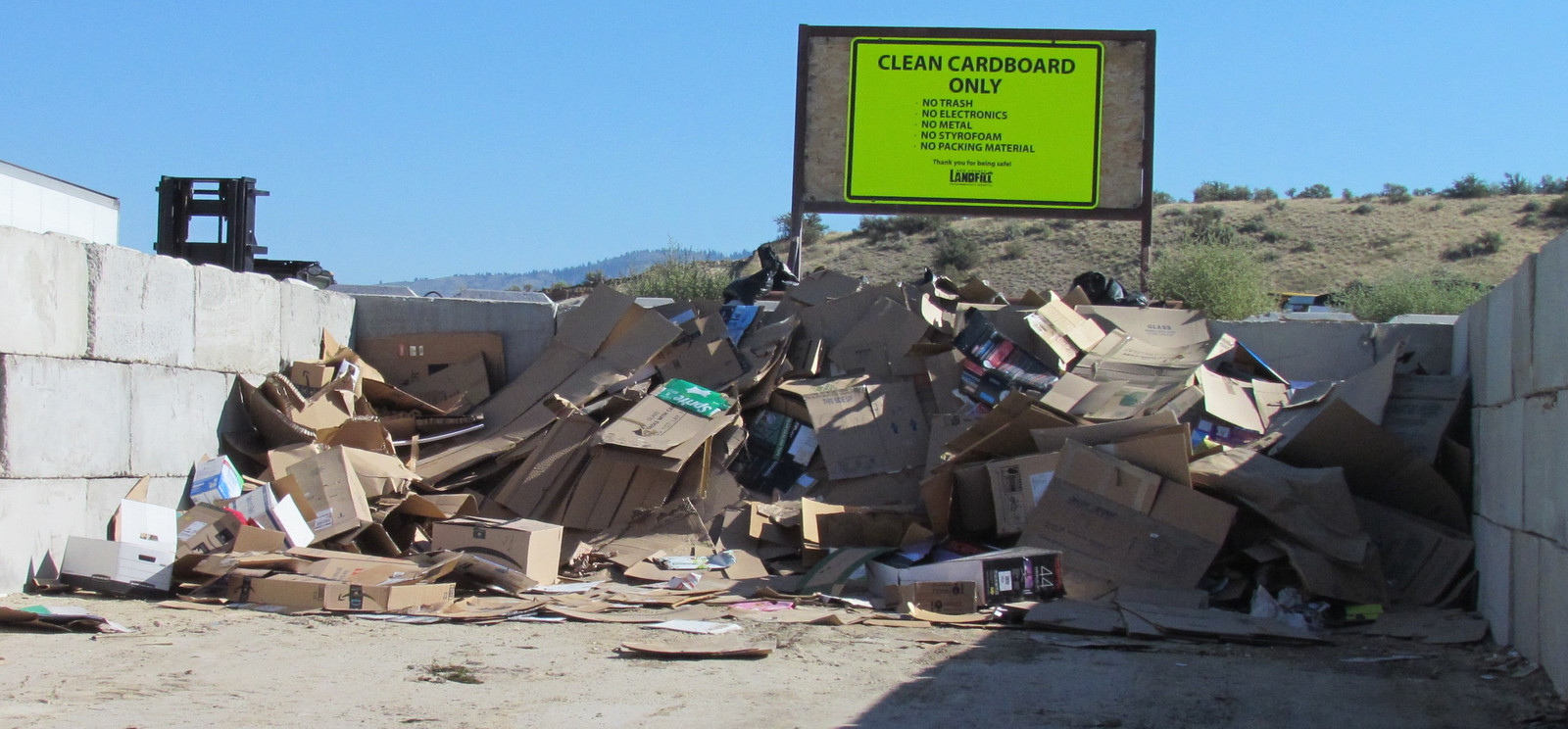
Finally, there’s an electronics recycling section. That which doesn’t go to the local rage rooms gets loaded in the semis for transport to somewhere in Colorado for further processing. I haven’t seen this many CRT TVs in one place in a very, very long time.
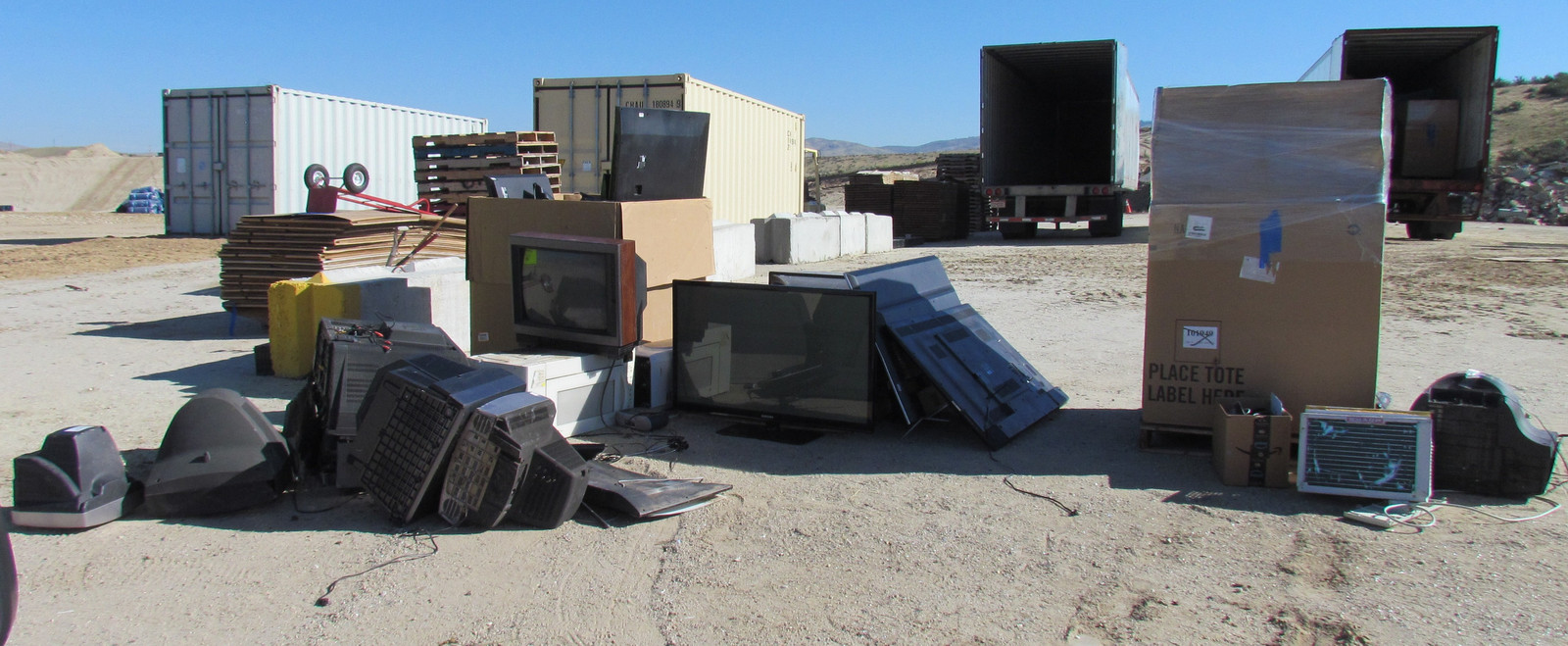
The Landfill
Past the diversion section, one comes to the landfill proper - or, at least, the section that is today’s dump site. This is what most people think of when they hear “dump” - and it generally delivers on that. It’s just… trash. Lots and lots of trash. Waste that can’t be (or isn’t) reduced, reused, or recycled. Acres and acres of trash. This is Stage 3, and work is currently under way for the 281 acre Stage 4 “North Ravine” section.
The big smashy thing on spiked metal wheels in the center here is the compactor. It rolls back and forth over the trash to mash it down.
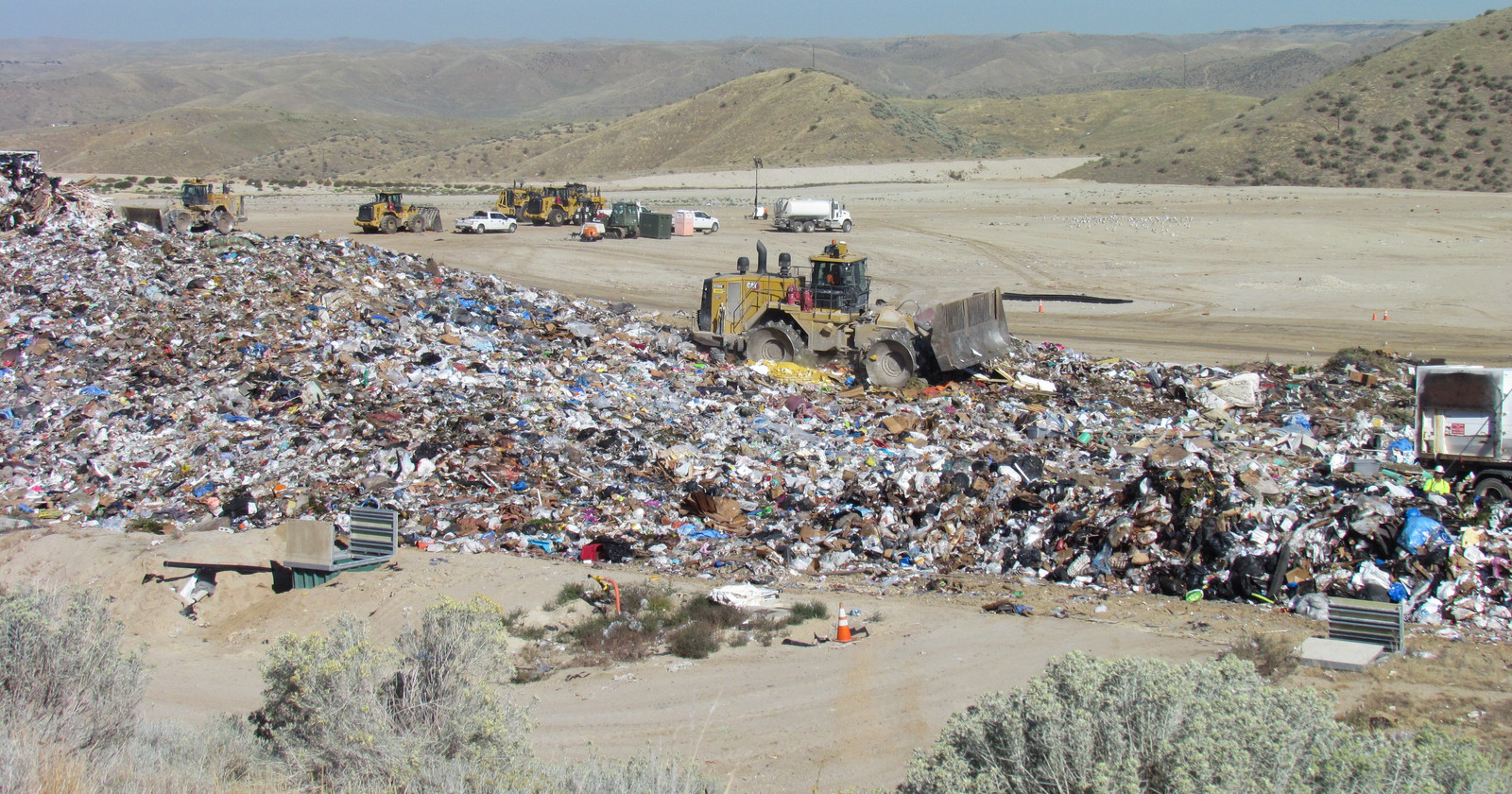
Trucks lined up at the edge of the trash pile offload their waste, and it’s pushed in. If you show up with a trailer and trash, you’ll be routed down here to offload things. If you have an offloader, great, otherwise just heave ho!
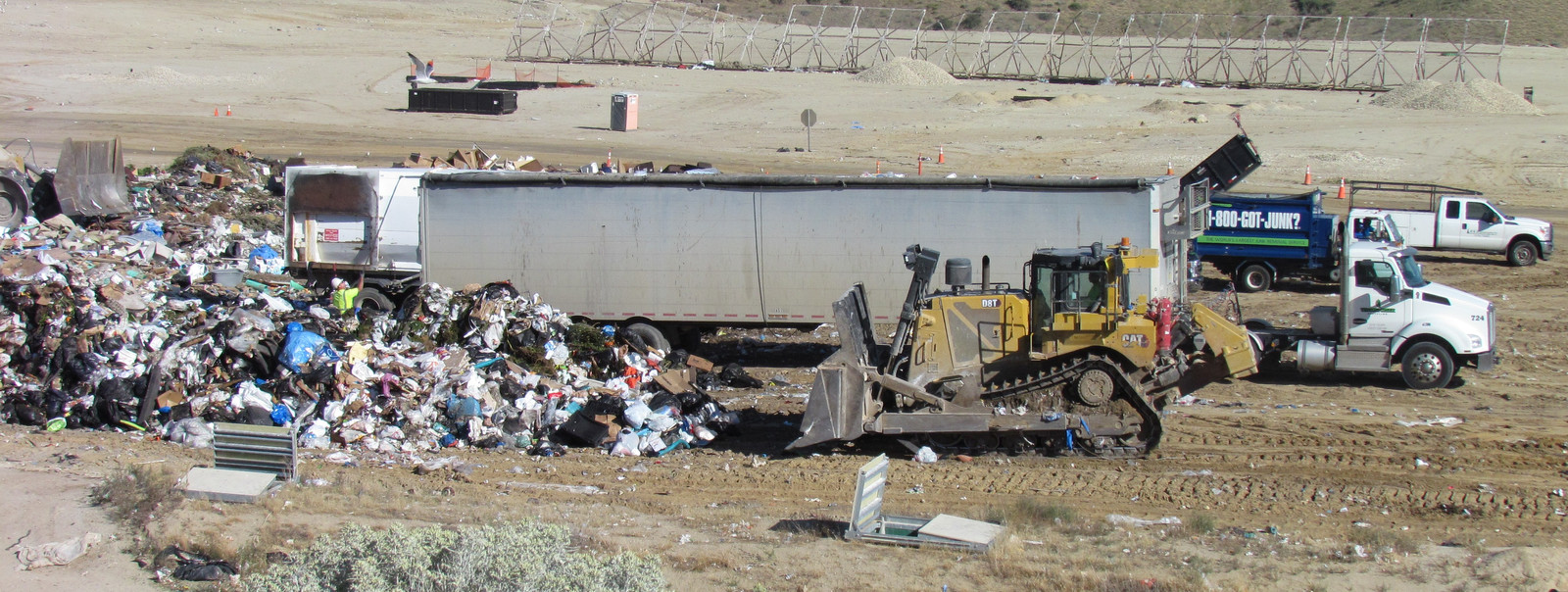
On the other side, one of the local trash trucks was offloading, along with another transfer station trailer - I understand those have a conveyer system built in so they just start sliding the trash out until everything has been pushed out. It doesn’t come out as an extruded cube of trash, but it’s not too far from it. Again, this is just the waste of modern life, collected and dumped.
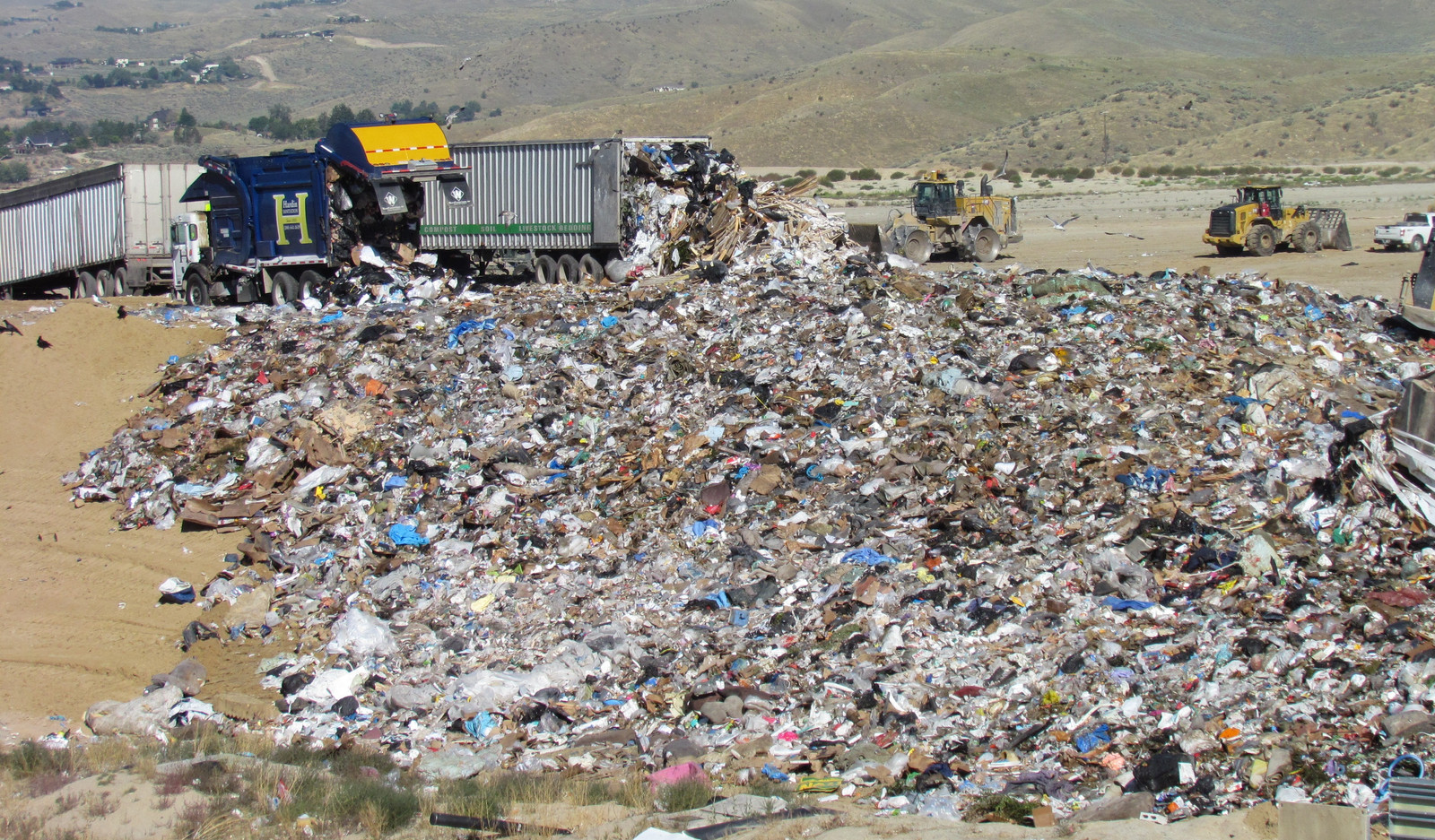
Ploop.
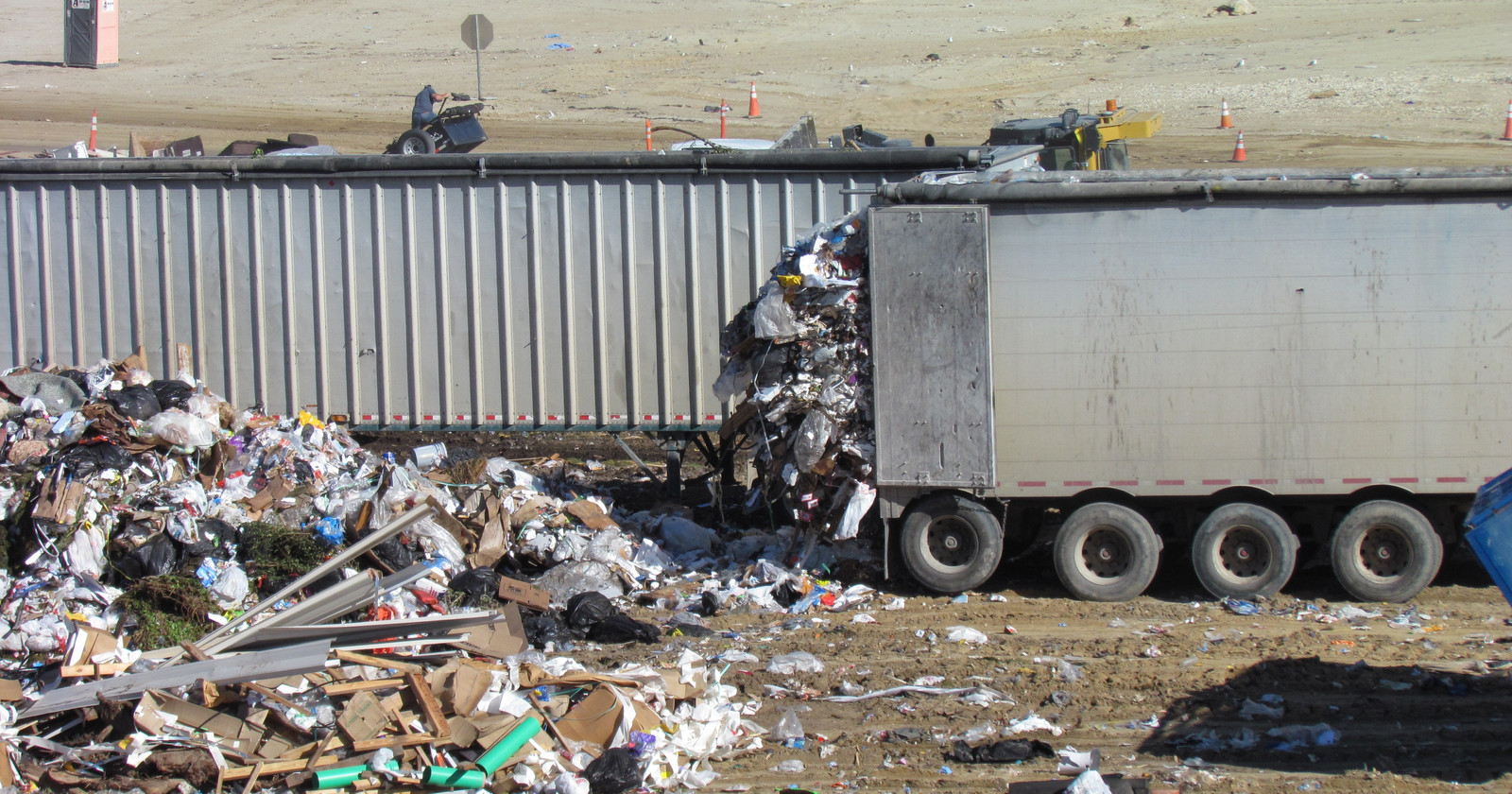
Trash. It’s actually a fairly nice day for it - you can see off into the distance. This is all hidden behind some foothills from Boise proper, and you’ll never see it unless you head up the landfill road (or happen to fly over it). You know how big a standard trash truck is - so scale from that. This is a “sanitary landfill,” which means that the trash is covered with dirt at the end of every day. It doesn’t just sit exposed rotting in the sun.
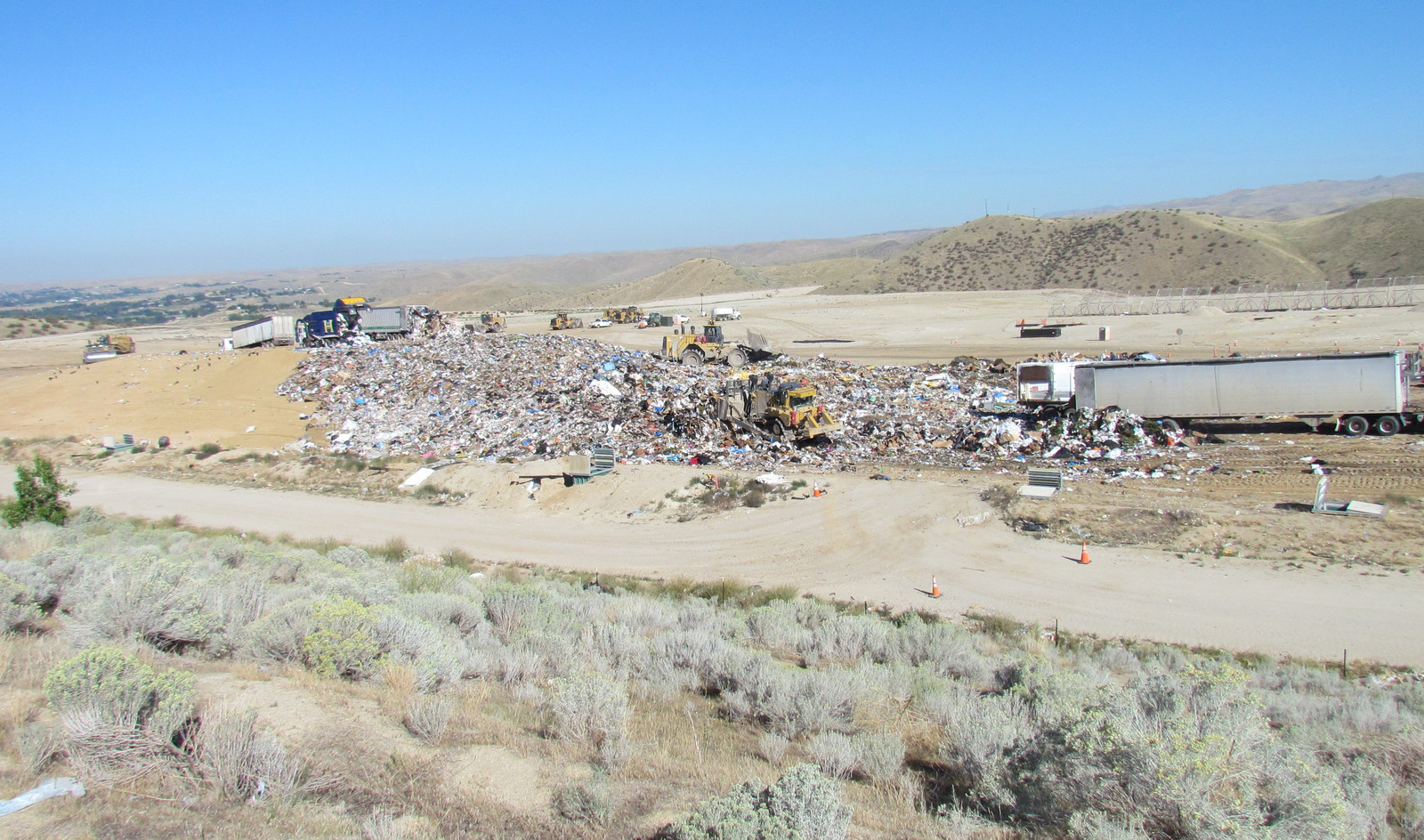
To the right of this is the new, 281 acre, Stage 4 North Ravine. This area is being prepared for trash - it’s being graded, liners put down, and the surrounding gas collection infrastructure set up. That’s nearly half a square mile - just for trash. And remember, despite how huge this seems, the landfill is filling up far faster than forecast.
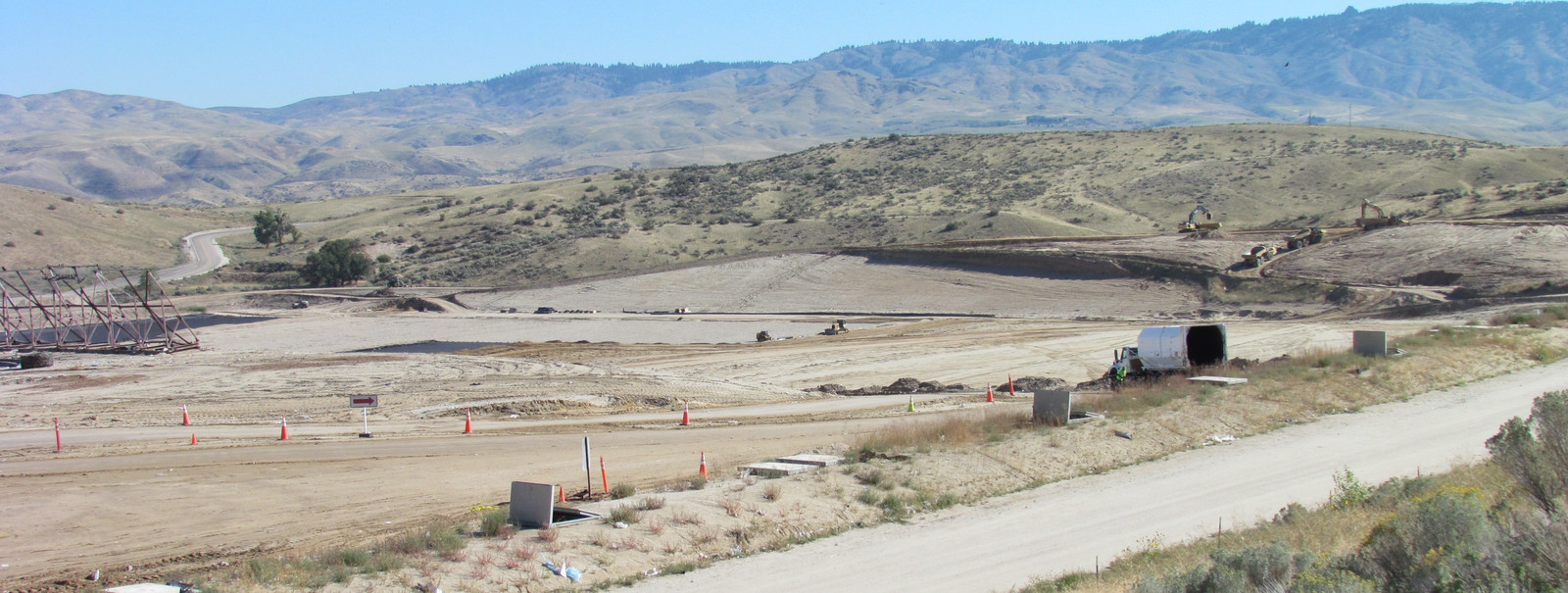
While there’s no shortage of heavy earthmoving (trashmoving?) equipment around, the two you see moving around (both here and over at Canyon County) are a big bulldozer and a compactor. The bulldozer mostly seems to push trash into the center - after some trucks have pulled out, it’ll push their dumpings into the center of the pile. The compactor? That just exists to smash everything into as flat a layer as possible. And neither of them are small.
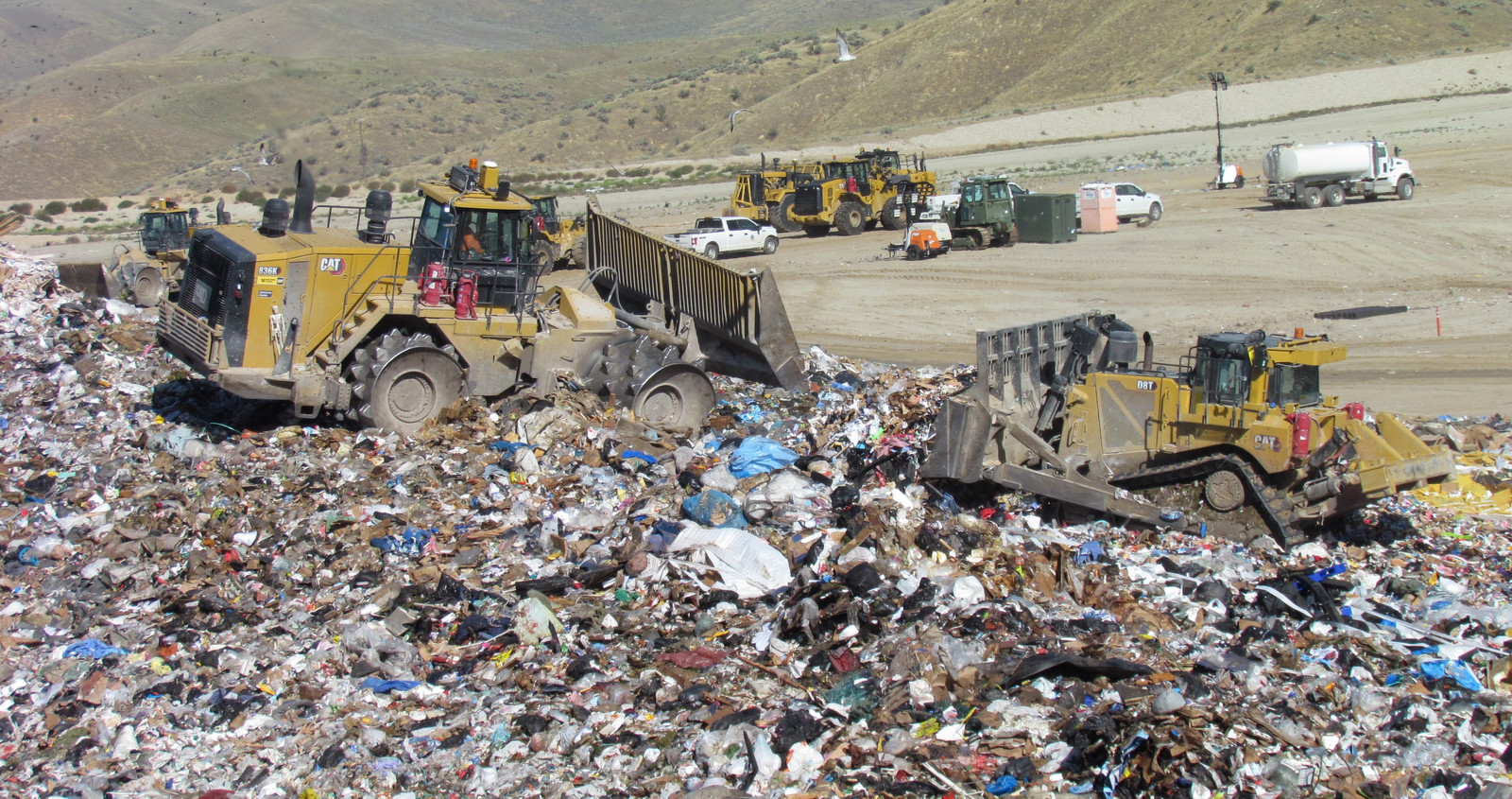
The bulldozer is a Cat D8T - a big boy. This weighs roughly 87,000 lbs and has about 310hp on tap to make sure everything gets moved. However, the ground loading is fairly low at 8 psi - this is for moving the waste, not smashing the waste.
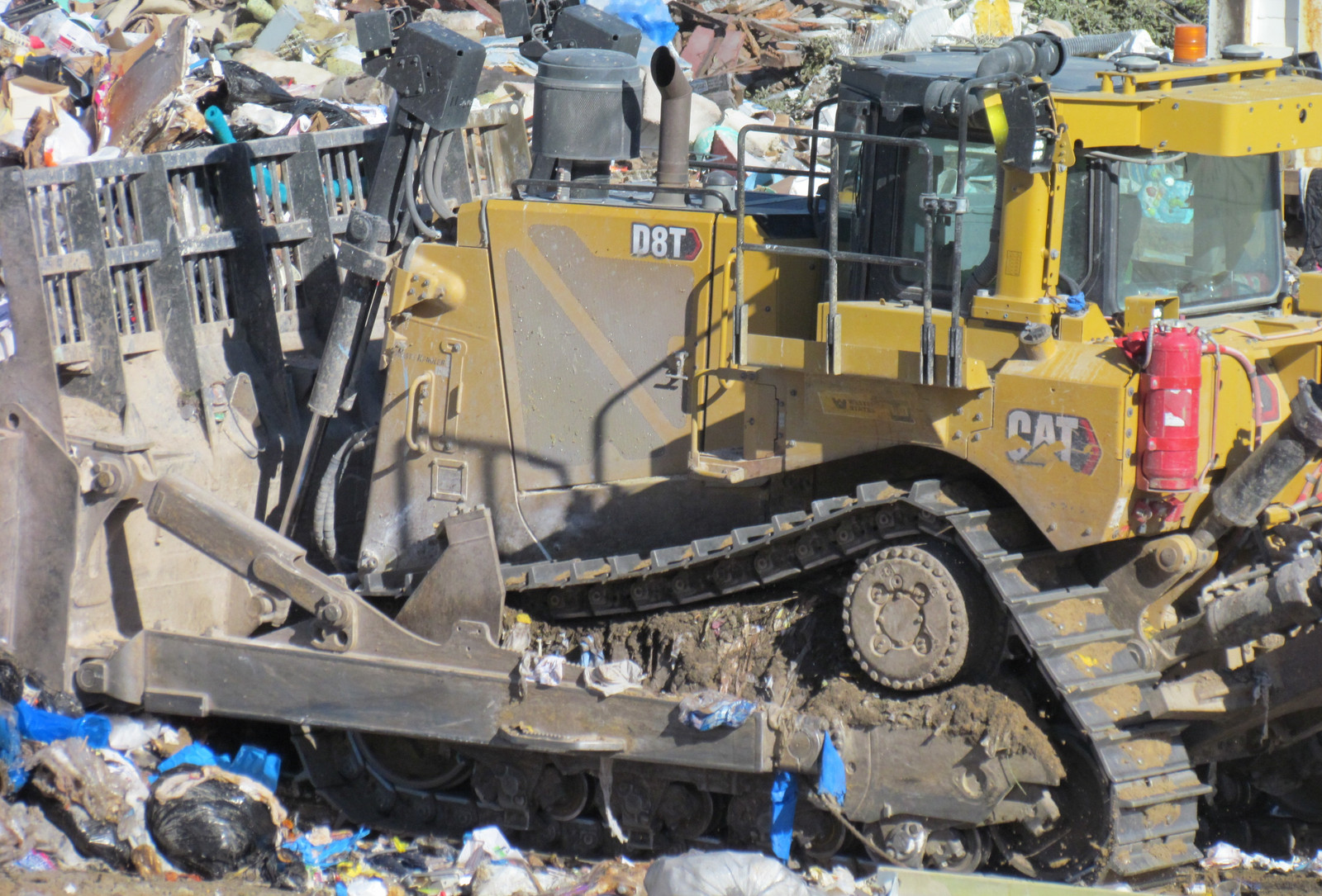
Although, instead of a ripper on the back, it has what looks like a fairly impressive “flattening attachment.”
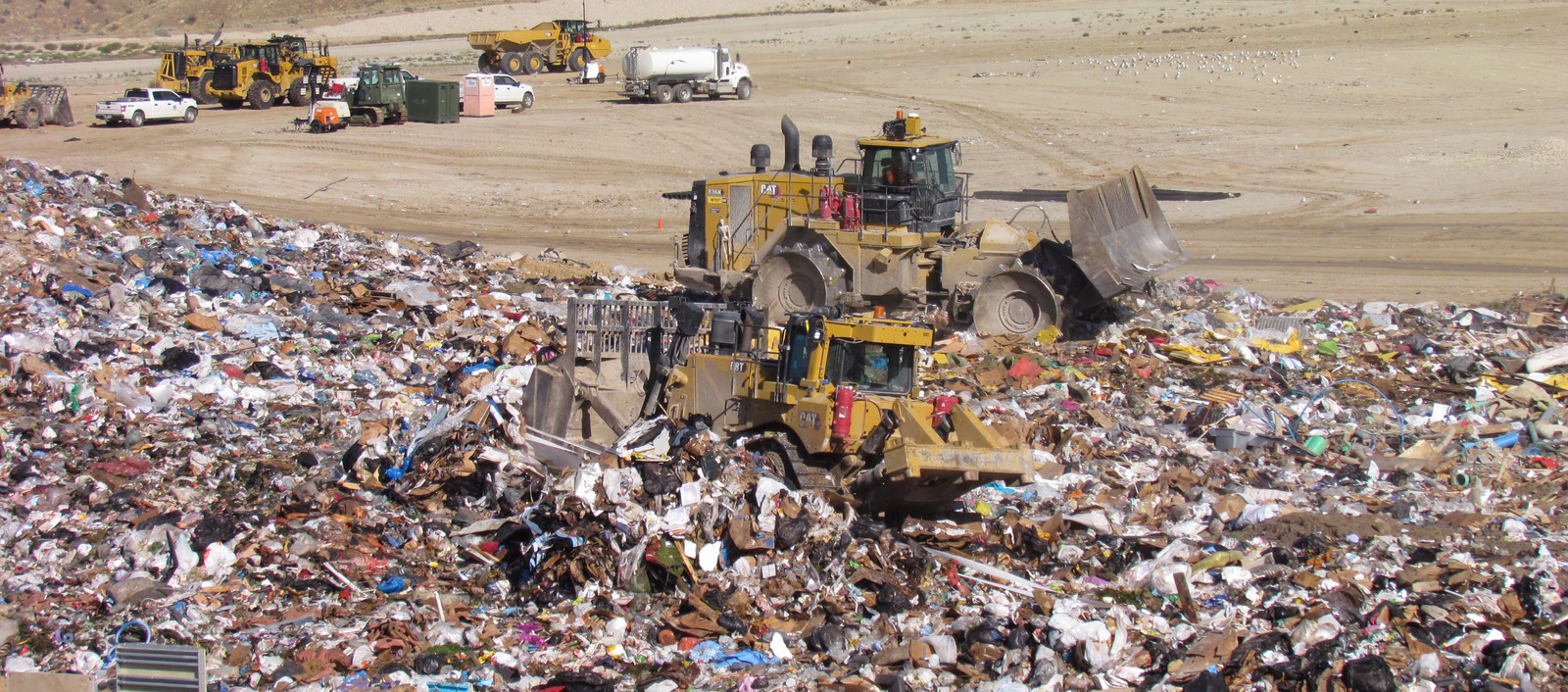
The bulk of the compaction, however, is handled by this - a Cat 836K Landfill Compactor. It’s a 500hp, 123,000lb monster purpose built for smashing trash. Each of the compactor wheels weighs about 10,000 lbs, and the spikes on them are designed to rip, tear, and smash layers of trash until it’s as dense as it can be. The cab includes useful readouts for tractive effort (apparently this helps determine when things are compacted), and GPS maps that ensure the operator “scribbles” over the entire landfill area to compact it.
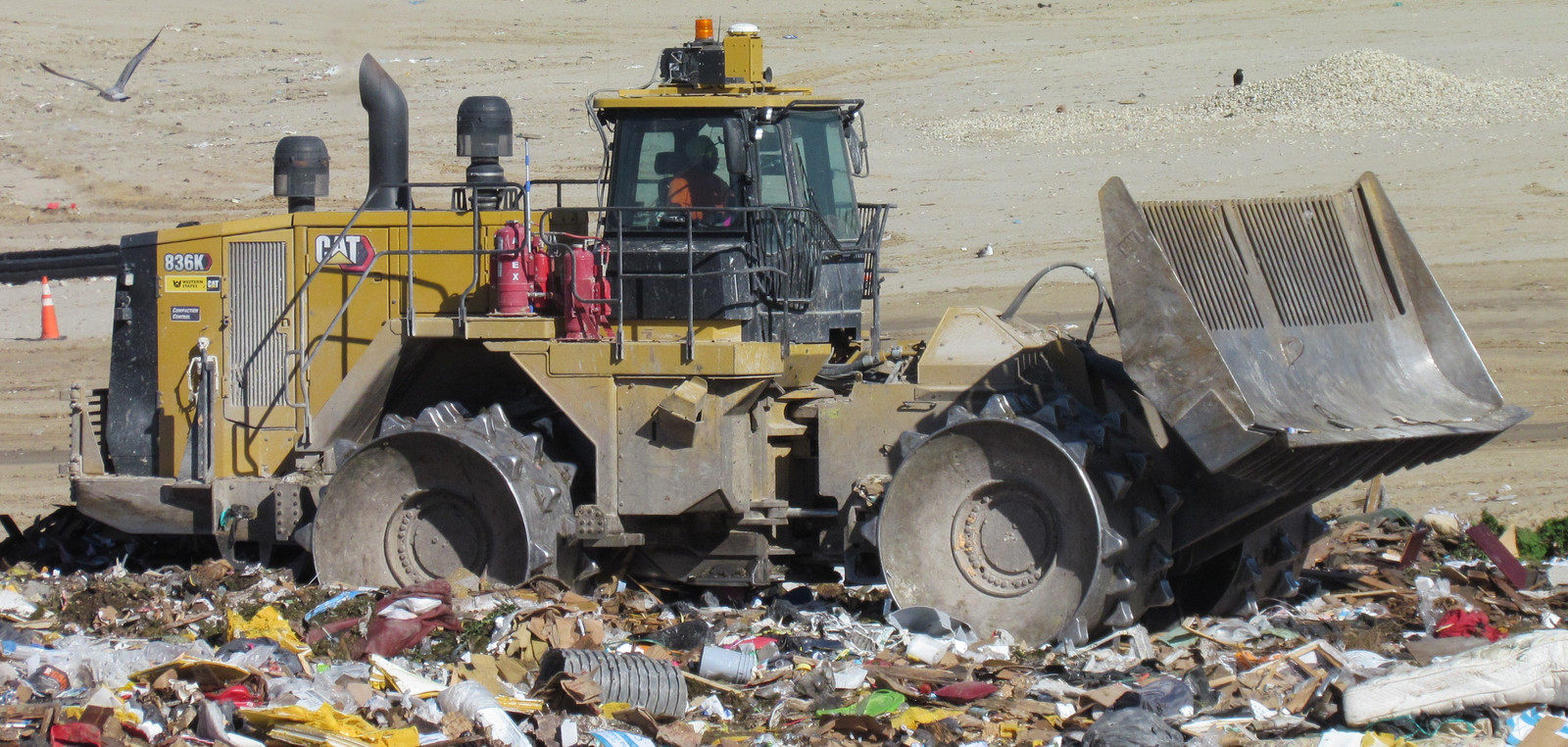
If you do your own oil changes, you might appreciate some of the fluid capacities on this beast. It’s got a 209 gallon fuel tank (with a 9 gallon DEF tank), the crankcase takes 16 gallons of oil, and it’ll take 28 gallons of coolant. The transmission takes 32 gallons, each differential (front and rear) takes about 50 gallons, and the hydraulic system tank is 63 gallons. Oh, and the oil change interval is 250 hours - so, every 32 days, if you’re doing 8 hour days.
Again, it’s worth emphasizing that this is a purpose built landfill waste compactor - that’s how much waste we generate as a bunch of humans. Cat builds a dedicated heavy machine just to mash trash.
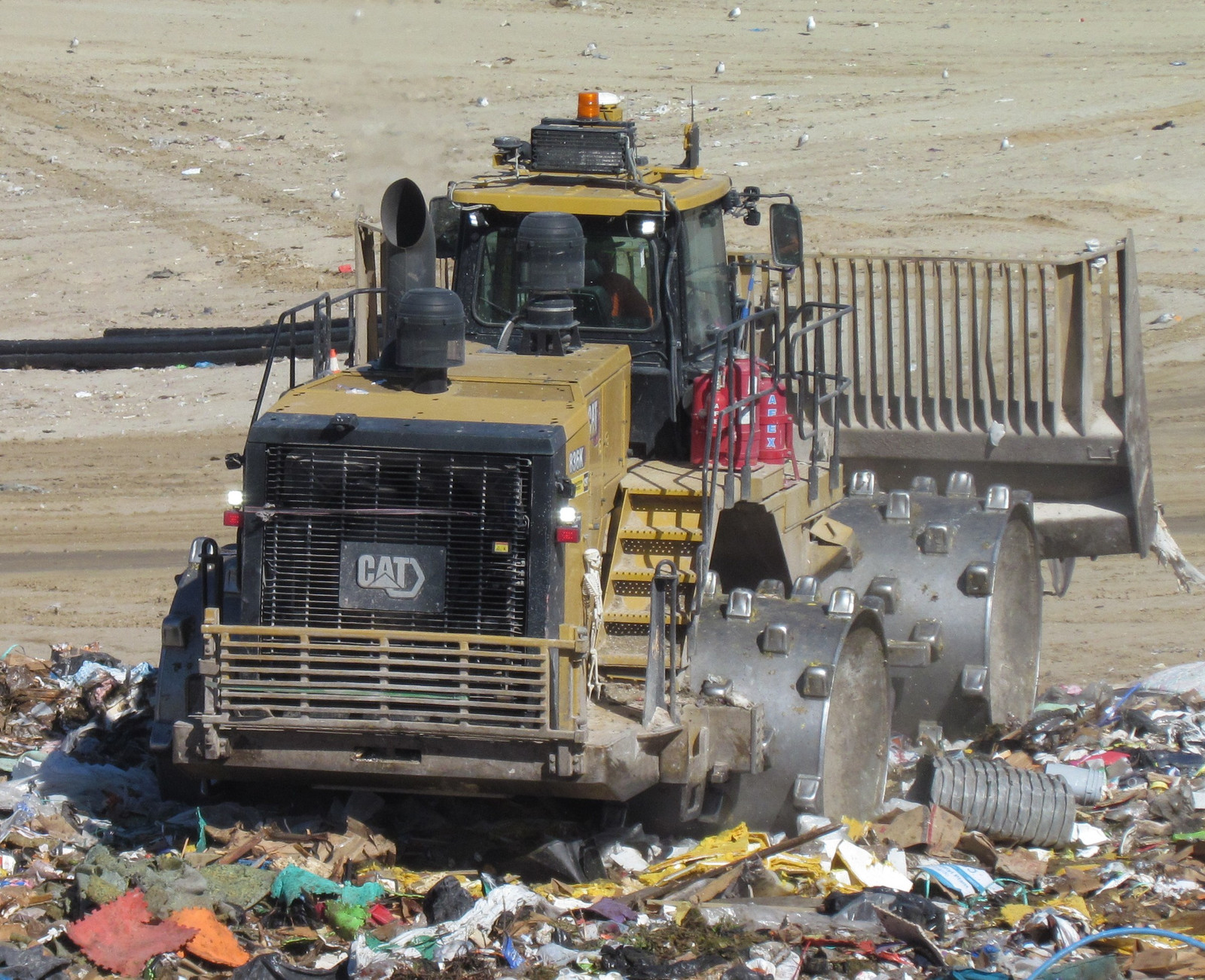
I’d drive it, though! I wonder if there’s a “Come drive a trash masher for an hour” program. If not, can I make a suggestion?
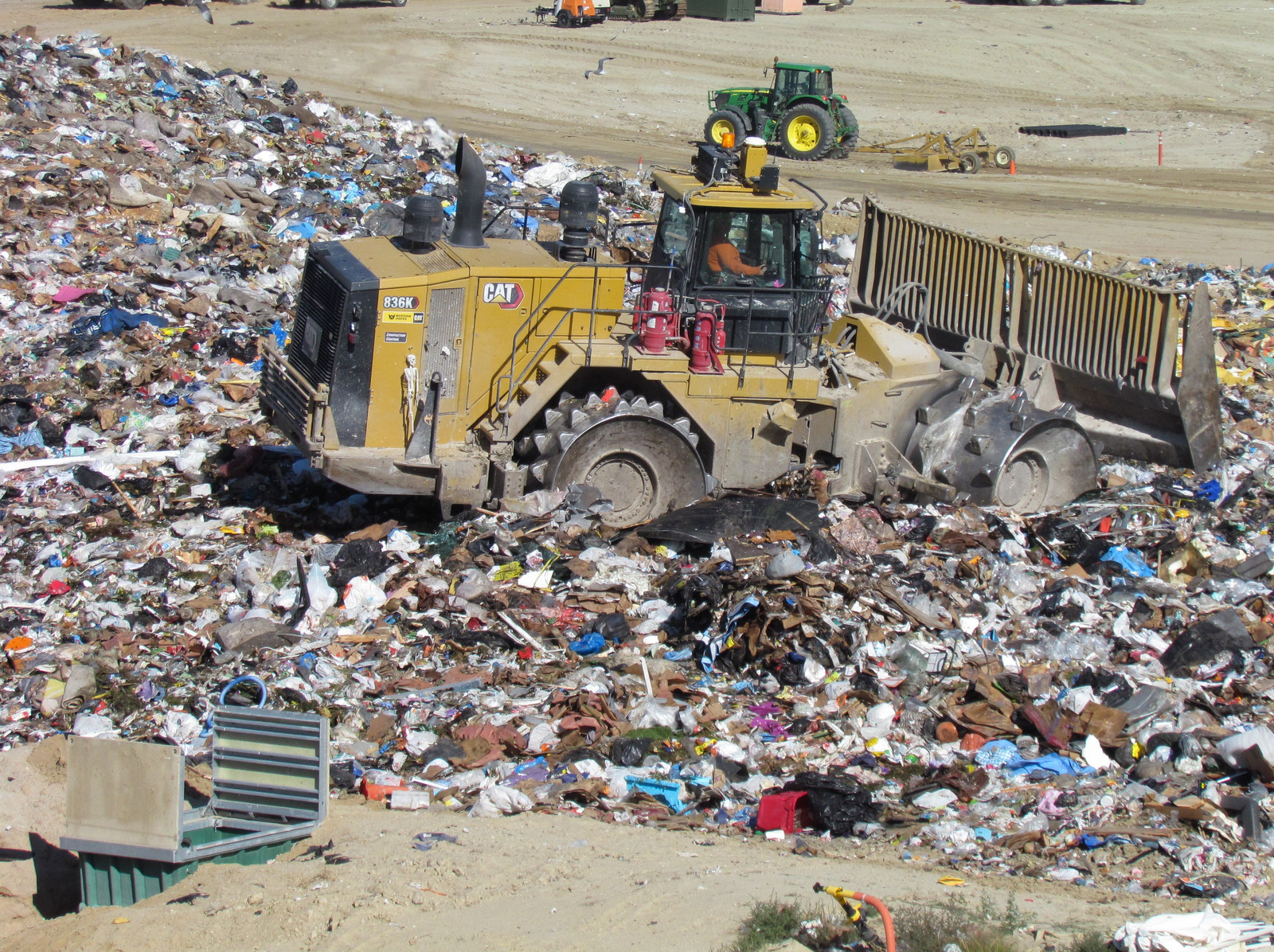
Plus a spare, plus a bunch of other heavy equipment back there for assorted earth moving reasons. They go through some diesel here.

The Leachate Ponds
What happens to the water and gas extracted from the landfills? It’s processed on-site. There are two large leachate ponds that are used to evaporate most of the water off, reducing the volume that needs to be dealt with.]
Recently, rat tailed maggots have been found in the leachate - which says decent things about the health of the water (at least in terms of supporting life). They’re the offspring of several species of hoverfly, and the “tail” is actually a snorkel it can extend to breathe while submerged in oxygen poor water with a lot of organic “stuff” in it.
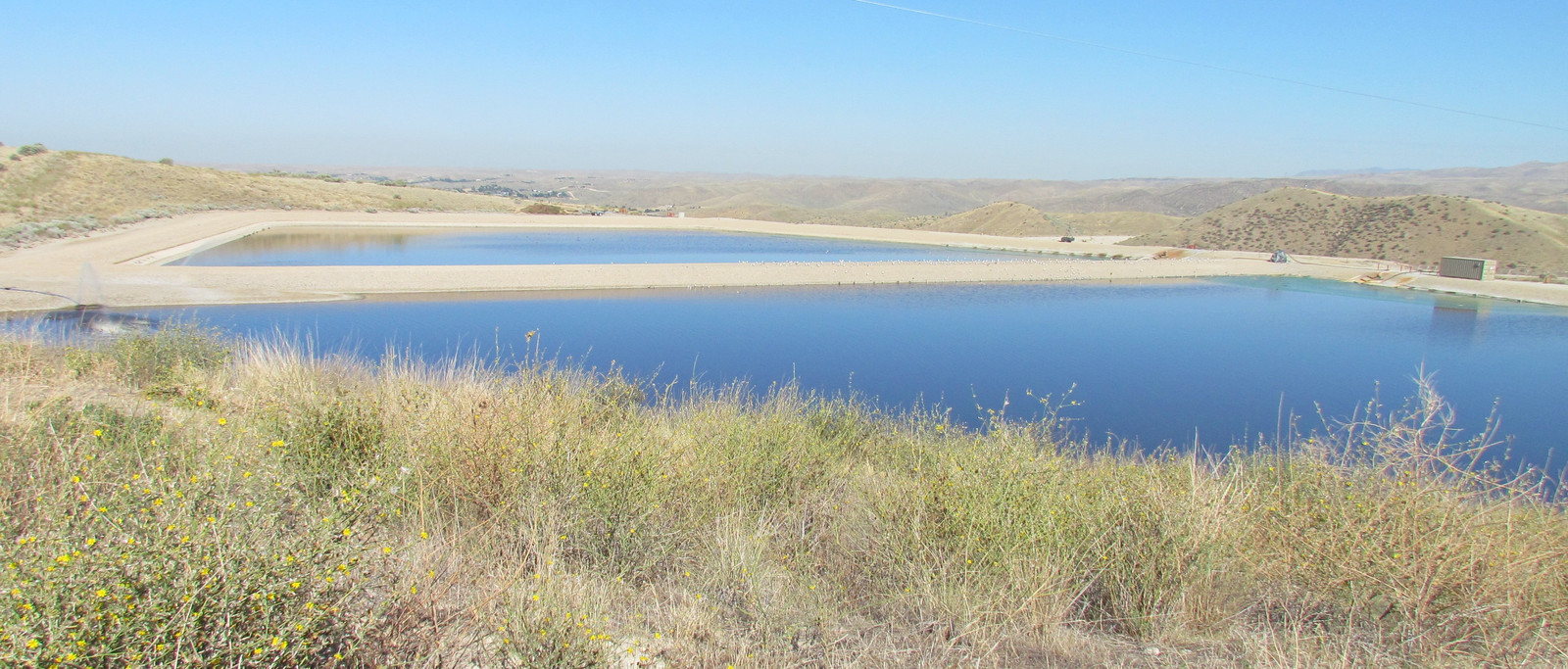
Aerators help keep the water moving and evaporating.
Ada County has been experimenting with some other uses for the leachate water as well - both mixing it into some covering foams for the landfill, and reinjecting it into the landfill to help stabilize things and produce more methane.
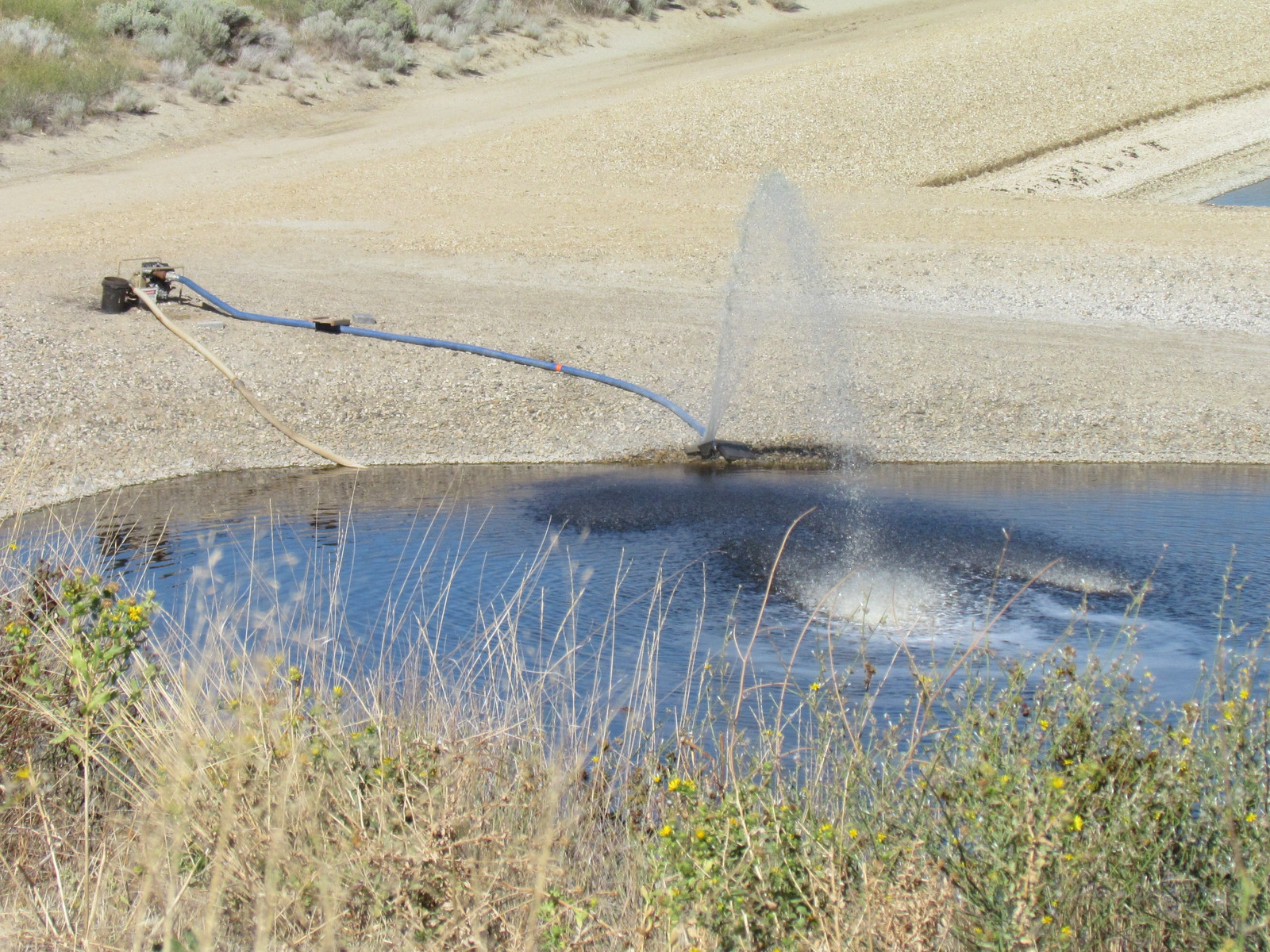
Beyond the landfill, there is a lot of area of “generally unused wildland” - and quite a few species call the place home.
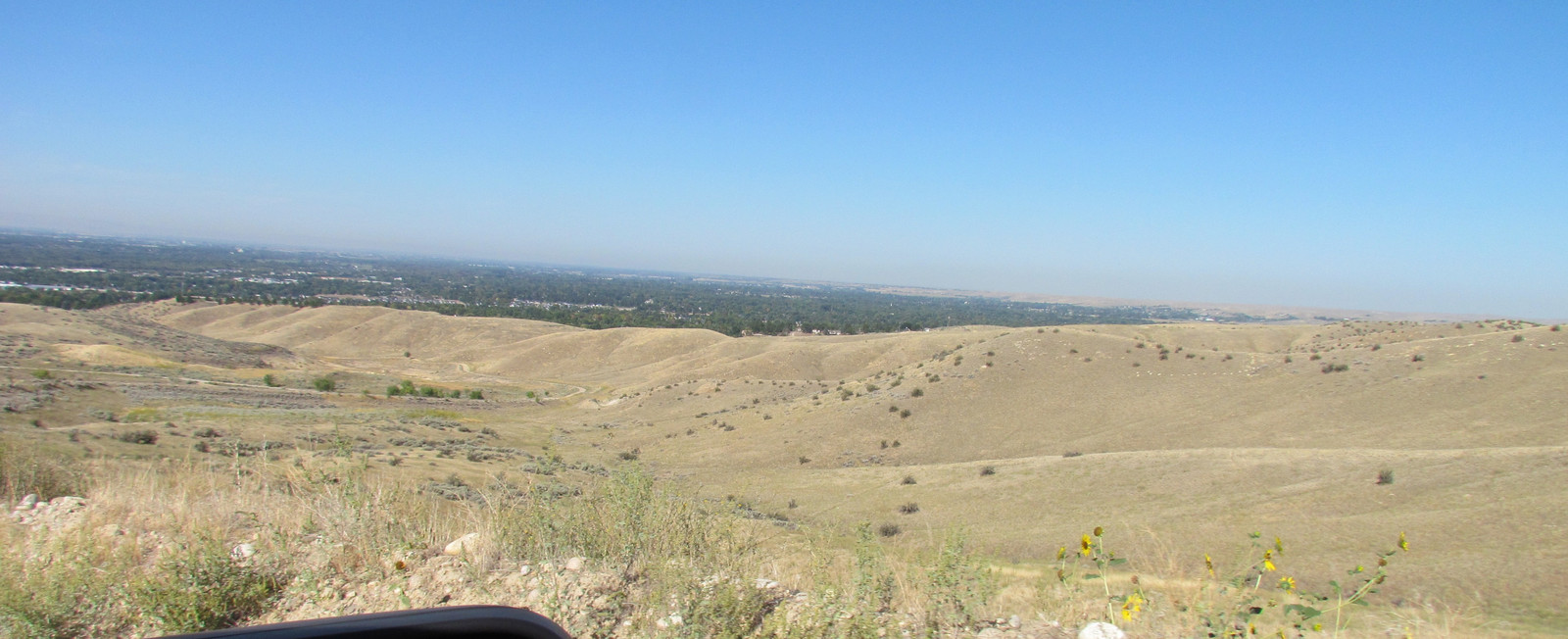
Landfill Gas Processing
Landfill gas from the rest of the facility is sucked via a negative pressure system (preventing leaks from emitting untreated gas) over to the processing facility through this pipe. The test points throughout the system are regularly checked for gas composition to ensure things are working as expected and that there are no leaks - they take emissions quite seriously out here.
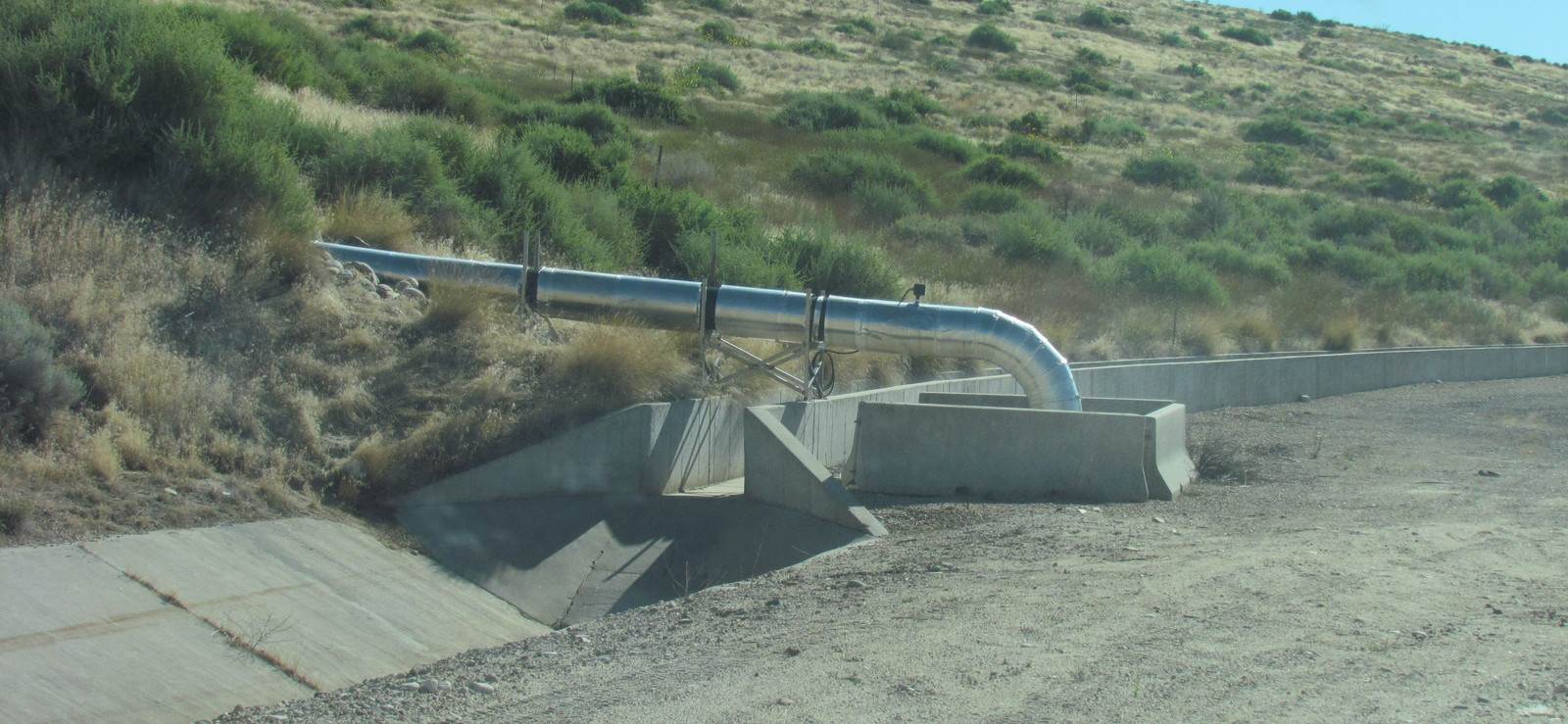
All the collected landfill gas goes into this facility. Nearest, a pair of enclosed flare stacks burn off whatever isn’t used by the two generators just beyond. And, at the far end, a set of six hydrogen sulfide scrubbers cleans the gas before it flows into the rest of the system. Our tour guide didn’t have too much information on these systems, so I found a proposal for expansion that gives me a few more details on the system.
From this document, I learned that Ada County’s landfill gas is about 50% methane and 50% CO2, plus other trace gasses that are a bit of a nuisance at times - plus the hydrogen sulfide that needs to be scrubbed.
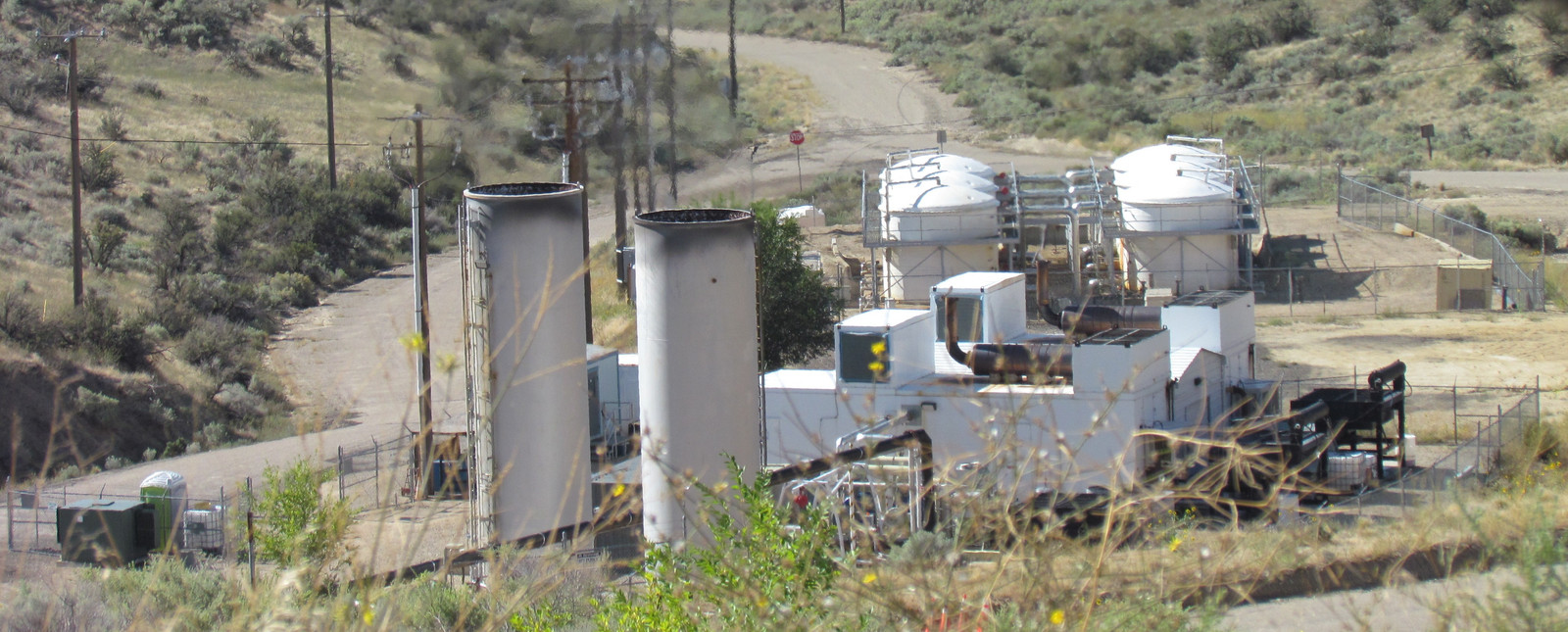
At the far end, gas comes through these MV Technologies hydrogen sulfide scrubbers. They’re set up as two banks of three - one bank is operational while the material in the other bank is being changed out. It uses an iron sponge media that ends up as non-hazardous landfillable waste after it’s saturated. I wonder where it can go…
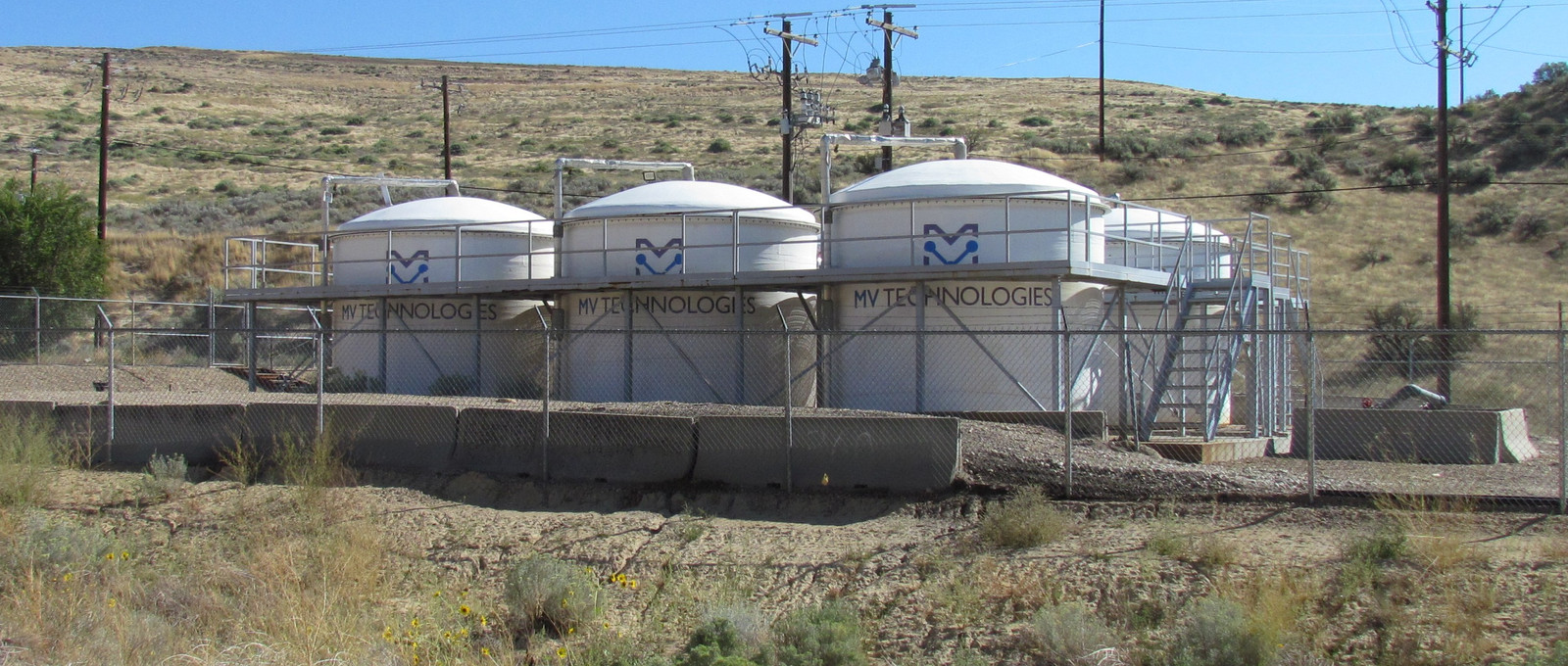
The first consumer of the gas is a pair of 1.6MW (2233hp) Caterpillar G3520C engines. That’s a 20 cylinder, 86 litre (5270 cubic inches) engine turning a capable genset, while burning 600 cfm (cubic feet per minute) of landfill gas. Not bad! This power is sold to the local power company, Idaho Power, via some purchasing agreements. However, the landfill is working with LFG Development to start scrubing their landfill gas to create renewable natural gas and export it into the local natural gas system - so the generators may not be around for too much longer.
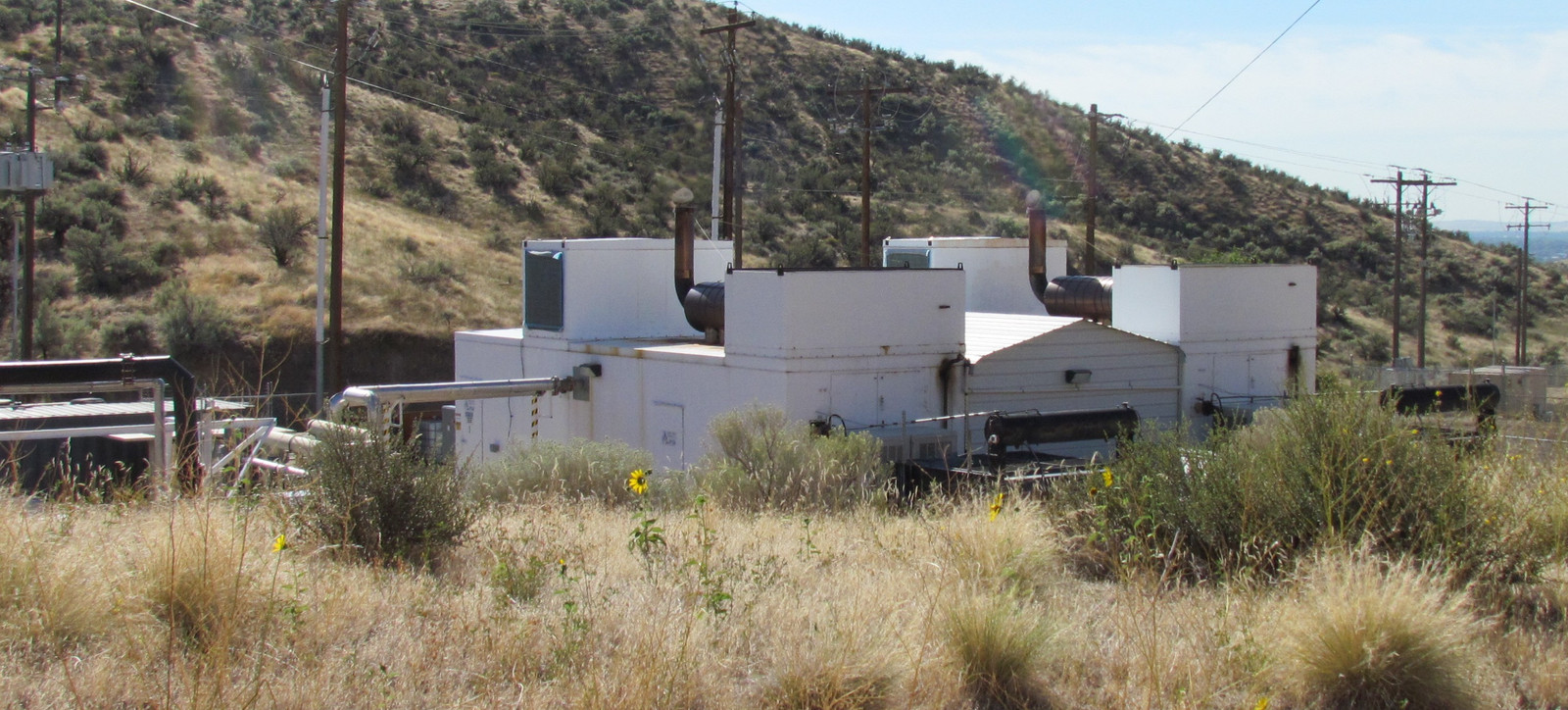
Finally, whatever is left over gets flared off in these enclosed flare stacks, operating between 1400 and 1800F with continual ignition (a propane fired pilot flame that ensures anything coming out is ignited).
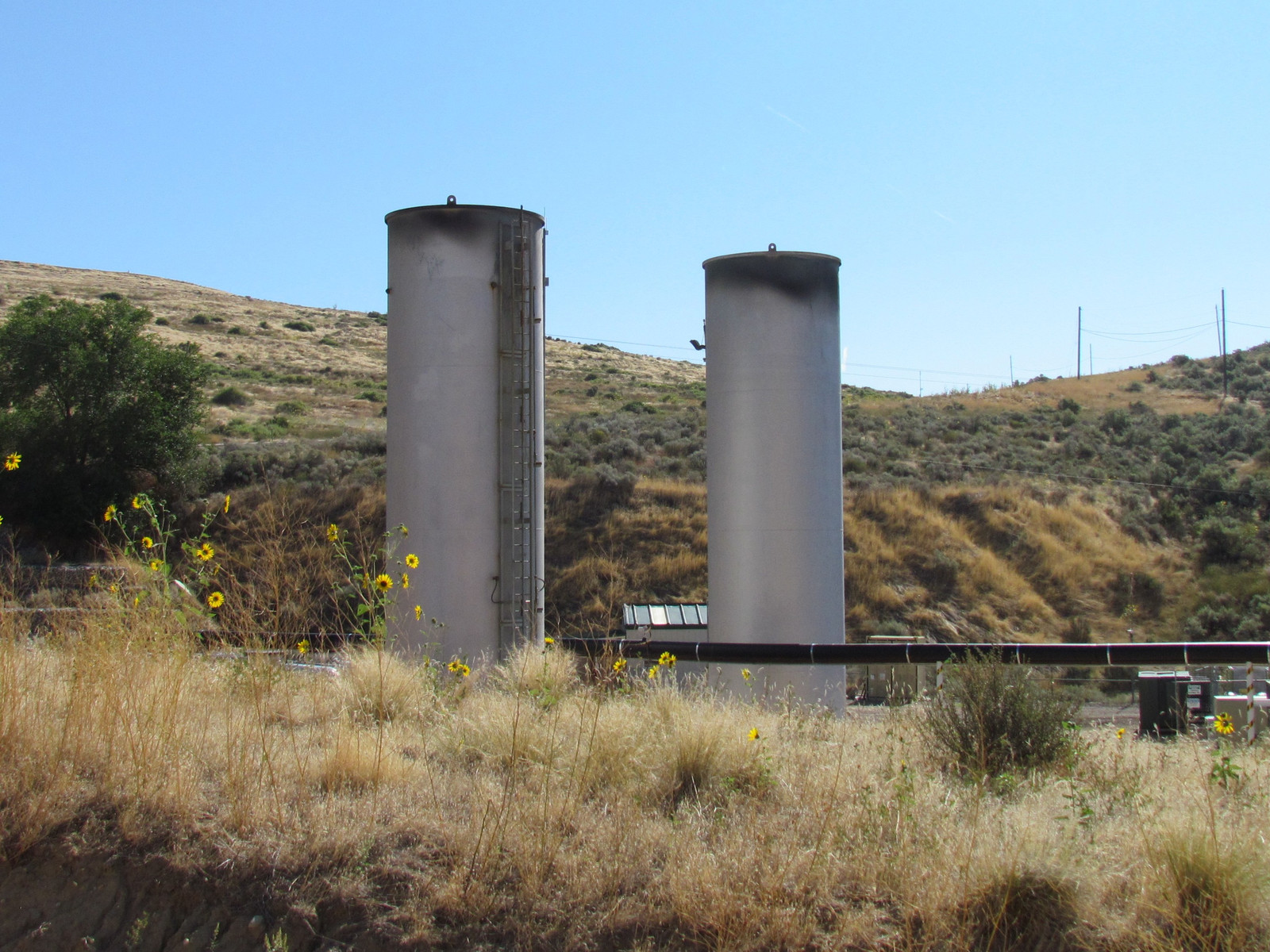
Hazmat Facility
Finally, there’s a hazmat facility for local household wastes that shouldn’t be landfilled. They deal with batteries, engine oil, and a variety of household chemicals and toxins.
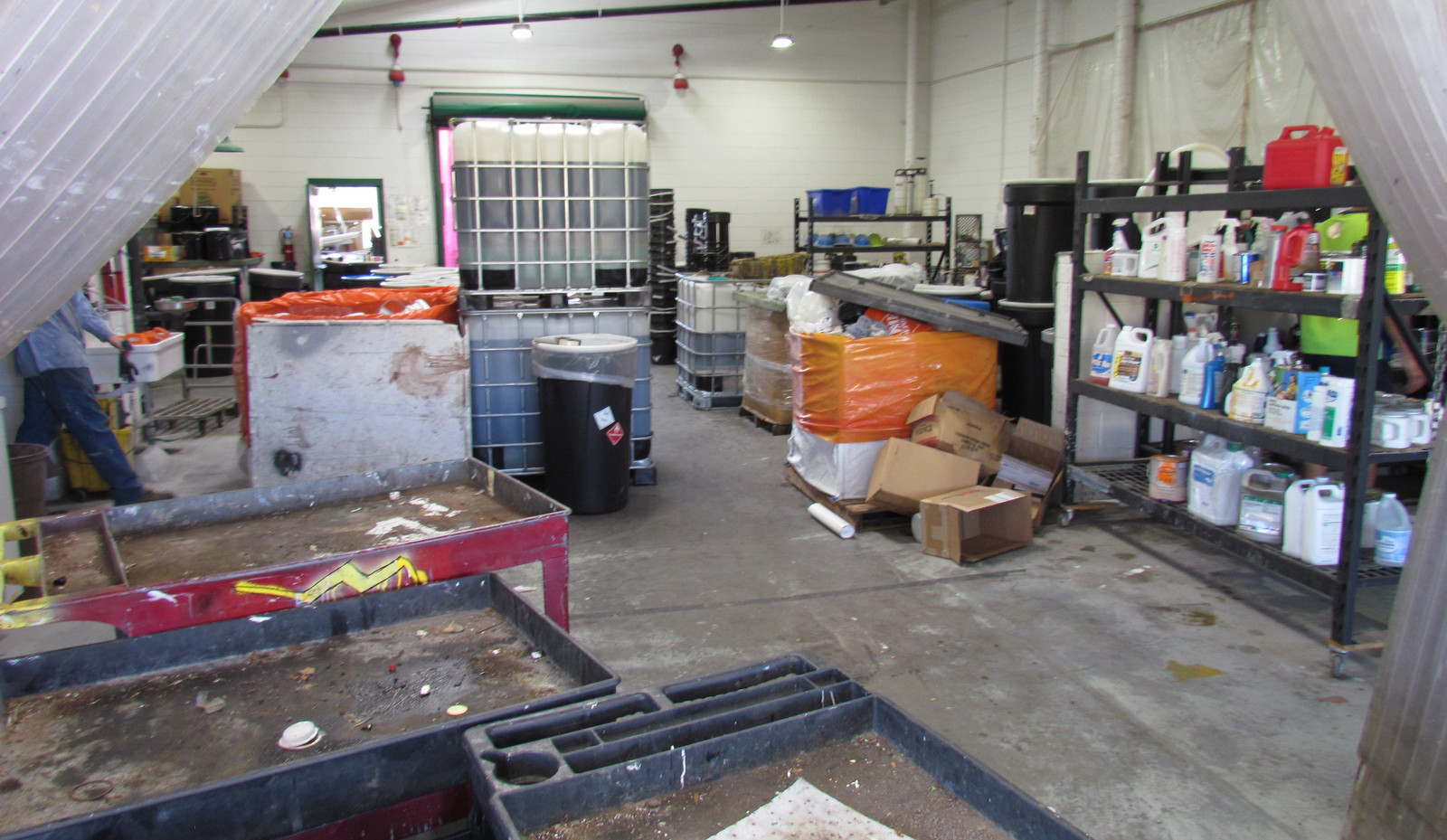
What I didn’t know is that they also separate out half full containers for reuse - you can show up and claim up to 4 items off the shelves. If you’re looking for cheap (free!) stains, paints, or other sorts of things, and aren’t picky about what you get, come check it out!
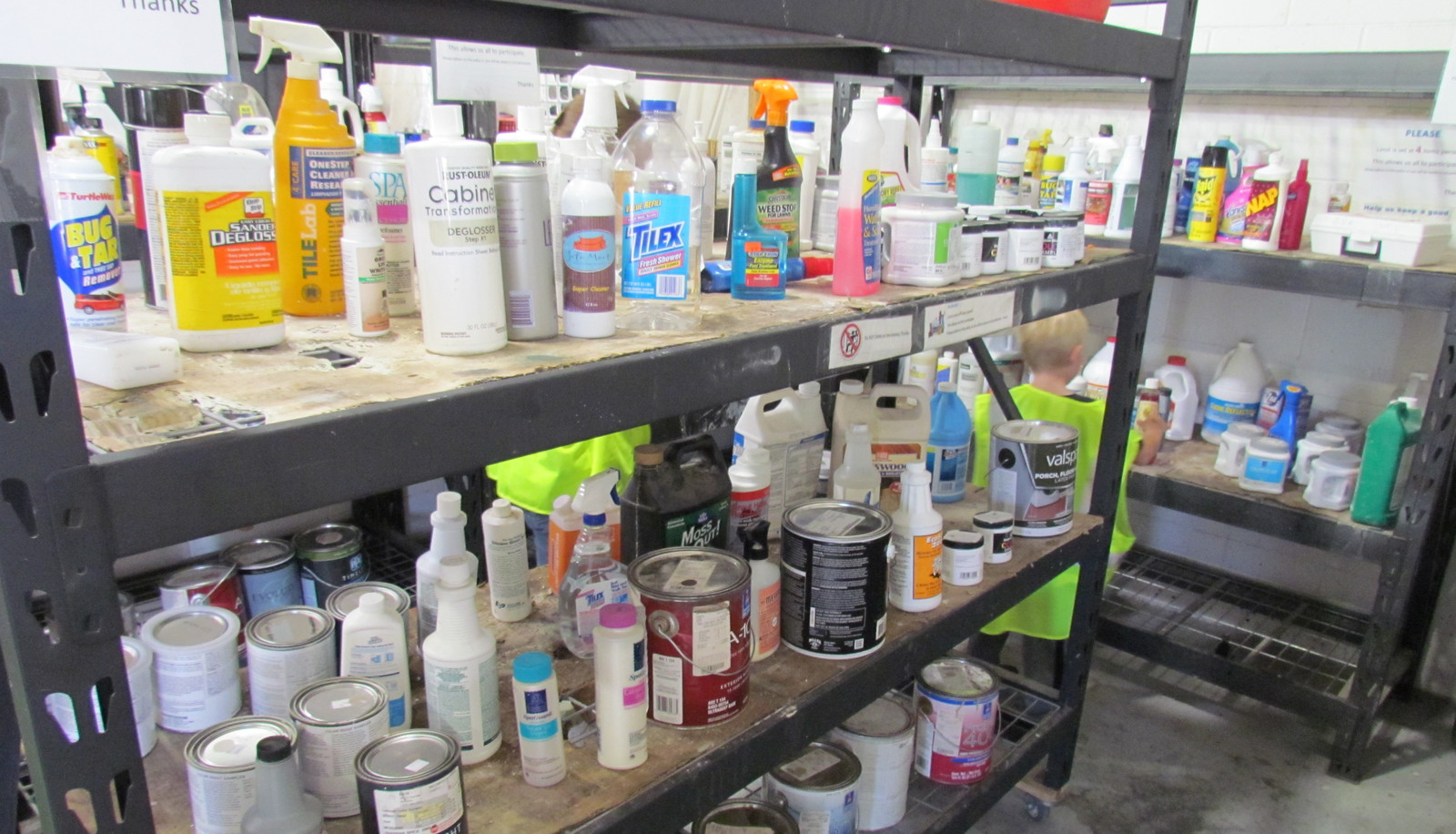
I honestly don’t know what half this stuff even is…
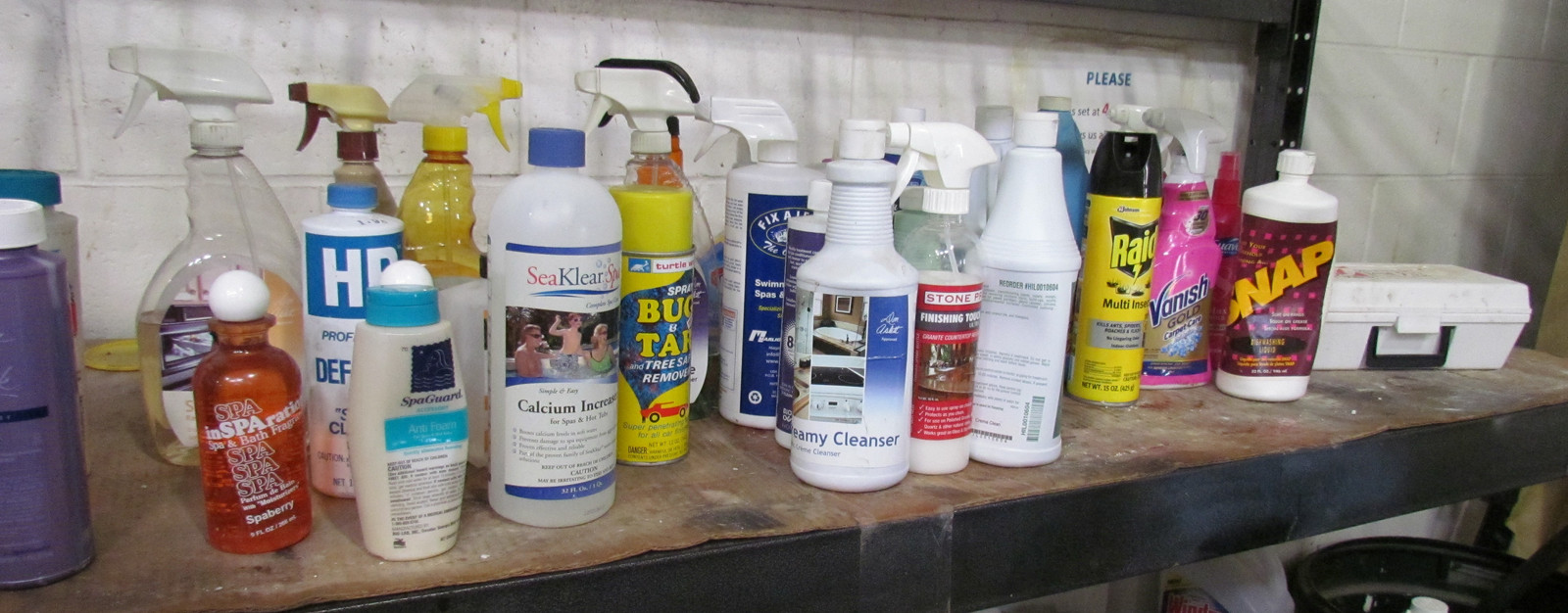
Seriously. Reduce your waste!
If you need some sort of motivation to work towards reducing your household waste, this should do it - our society generates tons of trash. The EPA calculates waste as about 4.9 pounds, per person, per day (or 1800 pounds - just under a ton - per year). That’s staggering, and if you’re anywhere close to that, you should aim to reduce it. We generate roughly 0.33 pounds per person per day of landfill waste, plus a bunch of recycling (I haul my own trash in the trash trailer I built, so I know exactly how much I’m hauling off). I’m working to reduce this over time through a reduction of disposable stuff coming in, as well as better handling of outbound waste - but, seriously, our society generates so much trash. Work towards zero waste!
Tour Your Local Landfill!
Anyway, if you’re around Ada County, go get a landfill tour! It’s fascinating!
Comments
Comments are handled on my Discourse forum - you'll need to create an account there to post comments.If you've found this post useful, insightful, or informative, why not support me on Ko-fi? And if you'd like to be notified of new posts (I post every two weeks), you can follow my blog via email! Of course, if you like RSS, I support that too.
